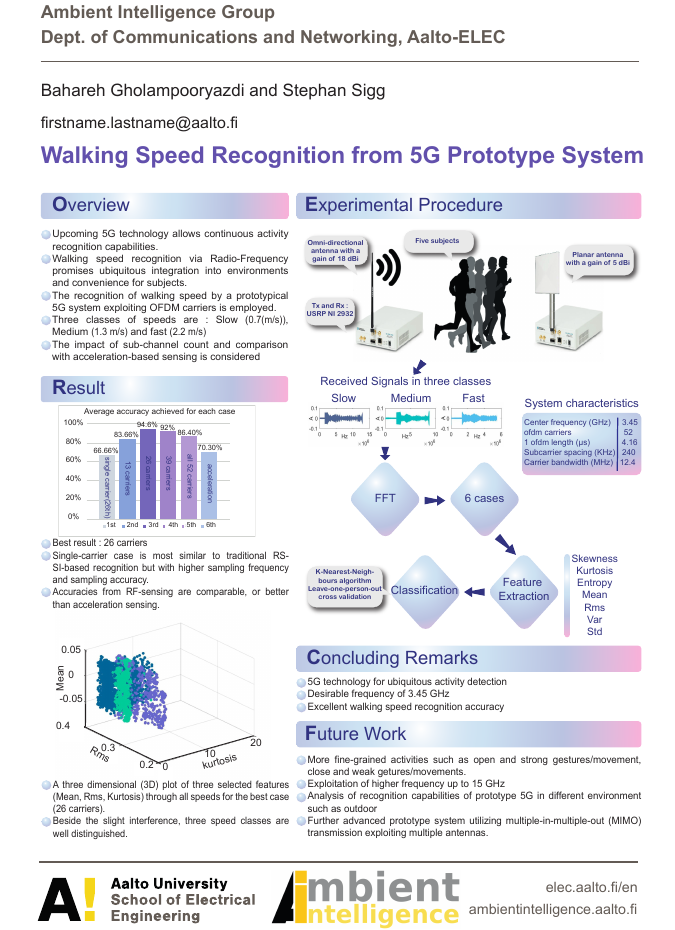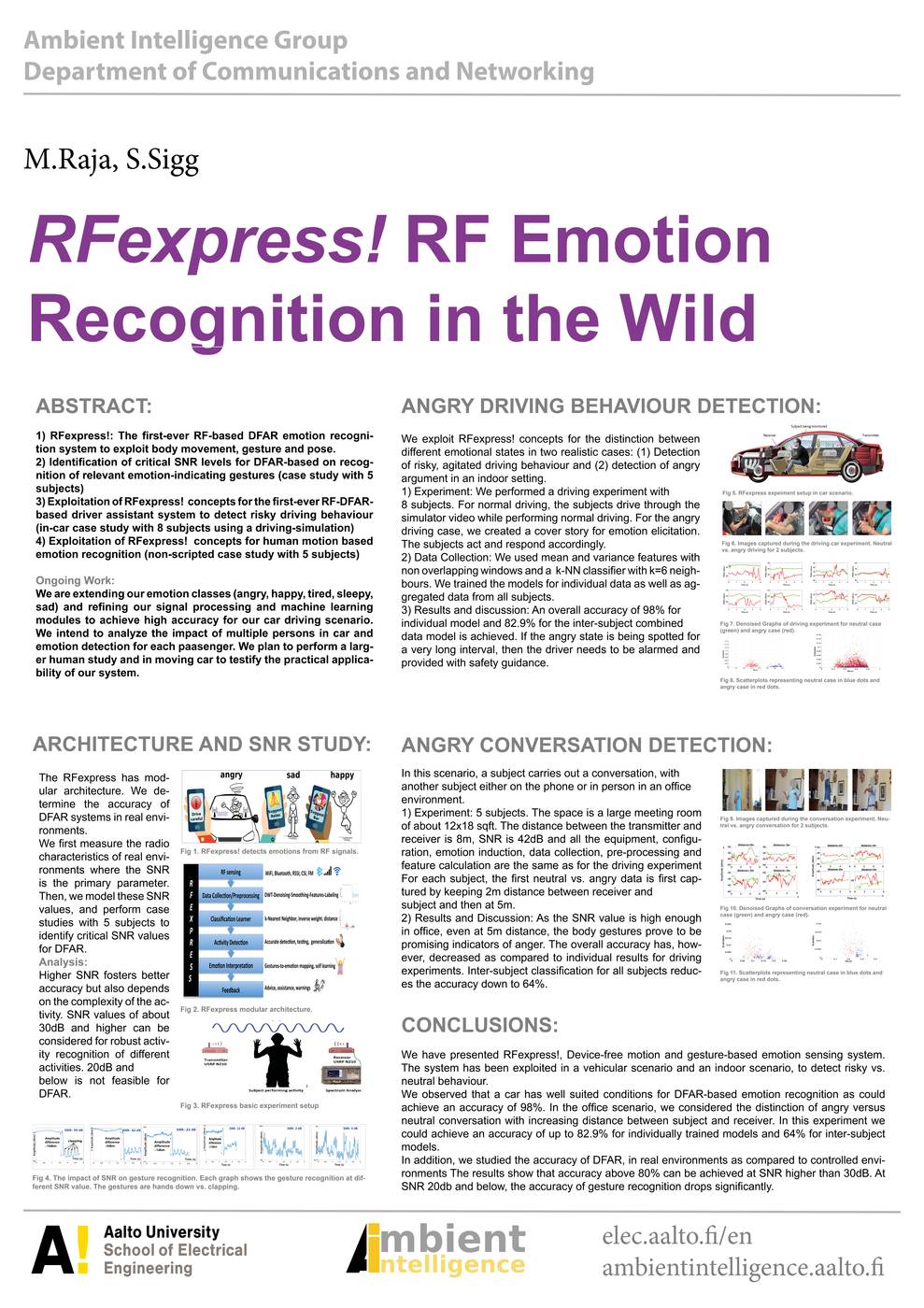
Jing Ma
- Aalto University
- Maarintie 8
- 00076 Espoo
- Finland
- xd07121031@126.com
I joined the Ambient Intelligence Group as a two-year visiting PhD student. My research interests include security of Machine Learning, Federated Learning and Blockchain. Further interests cover the privacy of Machine Learning data, and addressing the privacy problem by using cryptography and Blockchain.

Excellent! Next you can
create a new website with this list, or
embed it in an existing web page by copying & pasting
any of the following snippets.
JavaScript
(easiest)
PHP
iFrame
(not recommended)
<script src="https://bibbase.org/show?bib=https://ambientintelligence.aalto.fi/bibtex/LiteraturAll&folding=0&filter=author_short:Ma&jsonp=1"></script>
<?php
$contents = file_get_contents("https://bibbase.org/show?bib=https://ambientintelligence.aalto.fi/bibtex/LiteraturAll&folding=0&filter=author_short:Ma");
print_r($contents);
?>
<iframe src="https://bibbase.org/show?bib=https://ambientintelligence.aalto.fi/bibtex/LiteraturAll&folding=0&filter=author_short:Ma"></iframe>
For more details see the documention.
This is a preview! To use this list on your own web site
or create a new web site from it,
create a free account. The file will be added
and you will be able to edit it in the File Manager.
We will show you instructions once you've created your account.
To the site owner:
Action required! Mendeley is changing its API. In order to keep using Mendeley with BibBase past April 14th, you need to:
- renew the authorization for BibBase on Mendeley, and
- update the BibBase URL in your page the same way you did when you initially set up this page.
2024
(2)
EmotionAware 2024: Eighth International Workshop on Emotion Awareness for Pervasive Computing Beyond Traditional Approaches - Welcome and Committees.
David, K.; Dobbins, C.; Heinisch, J.; Okoshi, T.; Dupré, D.; Gaggioli, A.; Gao, N.; Peltonen, E.; Sugaya, M.; Tag, B.; Van Laerhoven, K.; Mariani, S.; and Sigg, S.
2024 IEEE International Conference on Pervasive Computing and Communications Workshops and other Affiliated Events, PerCom Workshops 2024,23–24. 2024.
2024 IEEE International Conference on Pervasive Computing and Communications Workshops and other Affiliated Events, PerCom Workshops 2024 ; Conference date: 11-03-2024 Through 15-03-2024
doi link bibtex
doi link bibtex
@article{d80aff910d284a788a9a368cb3e5e80f,
title = "EmotionAware 2024: Eighth International Workshop on Emotion Awareness for Pervasive Computing Beyond Traditional Approaches - Welcome and Committees",
author = "Klaus David and Chelsea Dobbins and Judith Heinisch and Tadashi Okoshi and Damien Dupr{\'e} and Andrea Gaggioli and Nan Gao and Ella Peltonen and Midori Sugaya and Benjamin Tag and {Van Laerhoven}, Kristof and Stefano Mariani and Stephan Sigg",
year = "2024",
doi = "10.1109/PerComWorkshops59983.2024.10502380",
language = "English",
pages = "23--24",
journal = "2024 IEEE International Conference on Pervasive Computing and Communications Workshops and other Affiliated Events, PerCom Workshops 2024",
note = "2024 IEEE International Conference on Pervasive Computing and Communications Workshops and other Affiliated Events, PerCom Workshops 2024 ; Conference date: 11-03-2024 Through 15-03-2024",
group = {ambience},
}
Awareness in Robotics: An Early Perspective from the Viewpoint of the EIC Pathfinder Challenge ``Awareness Inside''.
Della Santina, C.; Corbato, C. H.; Sisman, B.; Leiva, L. A.; Arapakis, I.; Vakalellis, M.; Vanderdonckt, J.; D'Haro, L. F.; Manzi, G.; Becchio, C.; Elamrani, A.; Alirezaei, M.; Castellano, G.; Dimarogonas, D. V.; Ghosh, A.; Haesaert, S.; Soudjani, S.; Stroeve, S.; Verschure, P.; Bacciu, D.; Deroy, O.; Bahrami, B.; Gallicchio, C.; Hauert, S.; Sanz, R.; Lanillos, P.; Iacca, G.; Sigg, S.; Gasulla, M.; Steels, L.; and Sierra, C.
In Secchi, C.; and Marconi, L., editor(s), European Robotics Forum 2024, pages 108–113, Cham, 2024. Springer Nature Switzerland
link bibtex abstract
link bibtex abstract
@InProceedings{10.1007/978-3-031-76424-0_20,
author="Della Santina, Cosimo
and Corbato, Carlos Hernandez
and Sisman, Burak
and Leiva, Luis A.
and Arapakis, Ioannis
and Vakalellis, Michalis
and Vanderdonckt, Jean
and D'Haro, Luis Fernando
and Manzi, Guido
and Becchio, Cristina
and Elamrani, A{\"i}da
and Alirezaei, Mohsen
and Castellano, Ginevra
and Dimarogonas, Dimos V.
and Ghosh, Arabinda
and Haesaert, Sofie
and Soudjani, Sadegh
and Stroeve, Sybert
and Verschure, Paul
and Bacciu, Davide
and Deroy, Ophelia
and Bahrami, Bahador
and Gallicchio, Claudio
and Hauert, Sabine
and Sanz, Ricardo
and Lanillos, Pablo
and Iacca, Giovanni
and Sigg, Stephan
and Gasulla, Manel
and Steels, Luc
and Sierra, Carles",
editor="Secchi, Cristian
and Marconi, Lorenzo",
title="Awareness in Robotics: An Early Perspective from the Viewpoint of the EIC Pathfinder Challenge ``Awareness Inside''",
booktitle="European Robotics Forum 2024",
year="2024",
publisher="Springer Nature Switzerland",
address="Cham",
pages="108--113",
abstract="While consciousness has been historically a heavily debated topic, awareness had less success in raising the interest of scholars. However, more and more researchers are getting interested in answering questions concerning what awareness is and how it can be artificially generated. The landscape is rapidly evolving, with multiple voices and interpretations of the concept being conceived and techniques being developed. The goal of this paper is to summarize and discuss the ones among these voices connected with projects funded by the EIC Pathfinder Challenge ``Awareness Inside'' callwithin Horizon Europe, designed specifically for fostering research on natural and synthetic awareness. In this perspective, we dedicate special attention to challenges and promises of applying synthetic awareness in robotics, as the development of mature techniques in this new field is expected to have a special impact on generating more capable and trustworthy embodied systems.",
isbn="978-3-031-76424-0",
group = {ambience},}
While consciousness has been historically a heavily debated topic, awareness had less success in raising the interest of scholars. However, more and more researchers are getting interested in answering questions concerning what awareness is and how it can be artificially generated. The landscape is rapidly evolving, with multiple voices and interpretations of the concept being conceived and techniques being developed. The goal of this paper is to summarize and discuss the ones among these voices connected with projects funded by the EIC Pathfinder Challenge ``Awareness Inside'' callwithin Horizon Europe, designed specifically for fostering research on natural and synthetic awareness. In this perspective, we dedicate special attention to challenges and promises of applying synthetic awareness in robotics, as the development of mature techniques in this new field is expected to have a special impact on generating more capable and trustworthy embodied systems.
2023
(2)
PPSFL: Privacy-preserving Split Federated Learning via Functional Encryption.
Ma, J.; Xixiang, L.; Yu, Y.; and Sigg, S.
. September 2023.
![Paper PPSFL: Privacy-preserving Split Federated Learning via Functional Encryption [link]](//bibbase.org/img/filetypes/link.svg) Paper
doi
link
bibtex
Paper
doi
link
bibtex
![Paper PPSFL: Privacy-preserving Split Federated Learning via Functional Encryption [link]](http://bibbase.org/img/filetypes/link.svg) Paper
doi
link
bibtex
Paper
doi
link
bibtex
@article{Ma_2023,
title={PPSFL: Privacy-preserving Split Federated Learning via Functional Encryption},
url={http://dx.doi.org/10.36227/techrxiv.24082659.v1},
DOI={10.36227/techrxiv.24082659.v1},
publisher={Institute of Electrical and Electronics Engineers (IEEE)},
author={Ma, Jing and Xixiang, Lv and Yu, Yong and Sigg, Stephan},
year={2023},
month=sep,
group = {ambience}}
Introduction to the Special Issue on Wireless Sensing for IoT.
Ma, H.; He, Y.; Li, M.; Patwari, N.; and Sigg, S.
ACM Trans. Internet Things, 4(4). December 2023.
![Paper Introduction to the Special Issue on Wireless Sensing for IoT [link]](//bibbase.org/img/filetypes/link.svg) Paper
doi
link
bibtex
abstract
Paper
doi
link
bibtex
abstract
![Paper Introduction to the Special Issue on Wireless Sensing for IoT [link]](http://bibbase.org/img/filetypes/link.svg) Paper
doi
link
bibtex
abstract
Paper
doi
link
bibtex
abstract
@article{10.1145/3633078,
author = {Ma, Huadong and He, Yuan and Li, Mo and Patwari, Neal and Sigg, Stephan},
title = {Introduction to the Special Issue on Wireless Sensing for IoT},
year = {2023},
issue_date = {November 2023},
publisher = {Association for Computing Machinery},
address = {New York, NY, USA},
volume = {4},
number = {4},
url = {https://doi.org/10.1145/3633078},
doi = {10.1145/3633078},
abstract = {ACM TIOT launched its first special issue on the theme of wireless sensing for IoT. As an important component of the special issue and a novel practice of the journal, an online virtual workshop will be held, with presentations for each of the accepted articles. Welcome to join us for online discussion! Free registration is required for an attendee of the workshop. The zoom link will be shared to registered attendees before the workshop.},
journal = {ACM Trans. Internet Things},
month = dec,
articleno = {21},
numpages = {4},
group = {ambience}}
%%% 2022 %%%
ACM TIOT launched its first special issue on the theme of wireless sensing for IoT. As an important component of the special issue and a novel practice of the journal, an online virtual workshop will be held, with presentations for each of the accepted articles. Welcome to join us for online discussion! Free registration is required for an attendee of the workshop. The zoom link will be shared to registered attendees before the workshop.
2022
(1)
Privacy-preserving federated learning based on multi-key homomorphic encryption.
Ma, J.; Naas, S.; Sigg, S.; and Lyu, X.
International Journal of Intelligent Systems. 2022.
link bibtex
link bibtex
@article{ma2022privacy,
title={Privacy-preserving federated learning based on multi-key homomorphic encryption},
author={Ma, Jing and Naas, Si-Ahmed and Sigg, Stephan and Lyu, Xixiang},
journal={International Journal of Intelligent Systems},
year={2022},
publisher={Wiley Online Library},
group = {ambience}}
2021
(3)
Adversary Models for Mobile Device Authentication.
Mayrhofer, R.; and Sigg, S.
ACM Computing Surveys,1-33. 2021.
doi link bibtex abstract
doi link bibtex abstract
@article{Mayrhofer_2021_ACMCS,
author={Rene Mayrhofer and Stephan Sigg},
journal={ACM Computing Surveys},
title={Adversary Models for Mobile Device Authentication},
year={2021},
abstract={Mobile device authentication has been a highly active research topic for over 10 years, with a vast range of methods proposed and analyzed.
In related areas, such as secure channel protocols, remote authentication, or desktop user authentication, strong, systematic, and increasingly formal threat models have been established and are used to qualitatively compare different methods.
However, the analysis of mobile device authentication is often based on weak adversary models, suggesting overly optimistic results on their respective security.
In this article, we introduce a new classification of adversaries to better analyze and compare mobile device authentication methods. We apply this classification to a systematic literature survey. The survey shows that security is still an afterthought and that most proposed protocols lack a comprehensive security analysis.
The proposed classification of adversaries provides a strong and practical adversary model that offers a comparable and transparent classification of security properties in mobile device authentication.
},
issue_date = {to appear},
publisher = {ACM},
volume = { },
number = { },
pages = {1-33},
group = {ambience},
doi = {10.1145/3477601}
}
Mobile device authentication has been a highly active research topic for over 10 years, with a vast range of methods proposed and analyzed. In related areas, such as secure channel protocols, remote authentication, or desktop user authentication, strong, systematic, and increasingly formal threat models have been established and are used to qualitatively compare different methods. However, the analysis of mobile device authentication is often based on weak adversary models, suggesting overly optimistic results on their respective security. In this article, we introduce a new classification of adversaries to better analyze and compare mobile device authentication methods. We apply this classification to a systematic literature survey. The survey shows that security is still an afterthought and that most proposed protocols lack a comprehensive security analysis. The proposed classification of adversaries provides a strong and practical adversary model that offers a comparable and transparent classification of security properties in mobile device authentication.
Camouflage Learning.
Sigg, S.; Nguyen, L. N.; and Ma, J.
In The 19th International Conference on Pervasive Computing and Communications (PerCom 2021), adjunct, 2021.
link bibtex abstract
link bibtex abstract
@inproceedings{Sigg2020Camouflage,
title={Camouflage Learning},
author={Stephan Sigg and Le Ngu Nguyen and Jing Ma},
booktitle={The 19th International Conference on Pervasive Computing and Communications (PerCom 2021), adjunct},
year={2021},
abstract={Federated learning has been proposed as a concept for distributed machine learning which enforces privacy by avoiding sharing private data with a coordinator or distributed nodes. Instead of gathering datasets to a central server for model training in traditional machine learning, in federated learning, model updates are computed locally at distributed devices and merged at a coordinator. However, information on local data might be leaked through the model updates. We propose Camouflage learning, a distributed machine learning scheme that distributes both the data and the model. Neither the distributed devices nor the coordinator is at any point in time in possession of the complete model. Furthermore, data and model are obfuscated during distributed model inference and distributed model training. Camouflage learning can be implemented with various Machine learning schemes.
},
group = {ambience},
project = {radiosense, abacus}
}
Federated learning has been proposed as a concept for distributed machine learning which enforces privacy by avoiding sharing private data with a coordinator or distributed nodes. Instead of gathering datasets to a central server for model training in traditional machine learning, in federated learning, model updates are computed locally at distributed devices and merged at a coordinator. However, information on local data might be leaked through the model updates. We propose Camouflage learning, a distributed machine learning scheme that distributes both the data and the model. Neither the distributed devices nor the coordinator is at any point in time in possession of the complete model. Furthermore, data and model are obfuscated during distributed model inference and distributed model training. Camouflage learning can be implemented with various Machine learning schemes.
EM model-based device-free localization of multiple bodies.
Rampa, V.; Nicoli, M.; Manno, C.; and Savazzi, S.
Sensors, 21(5): 1728. 2021.
link bibtex
link bibtex
@article{rampa2021model,
title={EM model-based device-free localization of multiple bodies},
author={Rampa, Vittorio and Nicoli, Monica and Manno, Chiara and Savazzi, Stefano},
journal={Sensors},
volume={21},
number={5},
pages={1728},
year={2021},
project = {radiosense},
publisher={Multidisciplinary Digital Publishing Institute}
}
2020
(2)
A structured measurement of highly synchronous real-time ballistocardiography signal data of heart failure patients.
Jähne-Raden, N.; Bavendiek, U.; Gutschleg, H.; Kulau, U.; Sigg, S.; Wolf, M. C.; Zeppernick, T.; and Marschollek, M.
In Studies in health technology and Informatics, 2020.
link bibtex
link bibtex
@InProceedings{Nico_2020_HeartFailure,
author = {Nico Jähne-Raden and Udo Bavendiek and Henrike Gutschleg and Ulf Kulau and Stephan Sigg and Marie Cathrine Wolf and Tanja Zeppernick and Michael Marschollek},
booktitle = {Studies in health technology and Informatics},
title = {A structured measurement of highly synchronous real-time ballistocardiography signal data of heart failure patients},
year = {2020},
project ={ballisto},
group={ambience}
}
Beamsteering for training-free Recognition of Multiple Humans Performing Distinct Activities.
Palipana, S.; Malm, N.; and Sigg, S.
In 18th Annual IEEE International Conference on Pervasive Computing and Communications (PerCom) , 2020.
doi link bibtex abstract
doi link bibtex abstract
@InProceedings{Sameera_2020_Beamsteering,
author = {Sameera Palipana and Nicolas Malm and Stephan Sigg},
booktitle = {18th Annual IEEE International Conference on Pervasive Computing and Communications (PerCom) },
title = {Beamsteering for training-free Recognition of Multiple Humans Performing Distinct Activities},
year = {2020},
doi = {10.1109/PerCom45495.2020.9127374},
abstract = {Recognition of the context of humans plays an important role in pervasive applications such as intrusion detection, human density estimation for heating, ventilation and air-conditioning in smart buildings, as well as safety guarantee for workers during human-robot interaction. Radio vision is able to provide these sensing capabilities with low privacy intrusion. A common challenge though, for current radio sensing solutions is to distinguish simultaneous movement from multiple subjects. We present an approach that exploits multi-antenna installations, for instance, found in upcoming 5G instrumentations, to detect and extract activities from spatially scattered human targets in an ad-hoc manner in arbitrary environments and without prior training of the multi-subject detection. We perform receiver-side beamforming and beam-steering over different azimuth angles to detect human presence in those regions separately. We characterize the resultant fluctuations in the spatial streams due to human influence using a case study and make the traces publicly available. We demonstrate the potential of this approach through two applications: 1) By feeding the similarities of the resulting spatial streams into a clustering algorithm, we count the humans in a given area without prior training. (up to 6 people in a 22.4m2 area with an accuracy that significantly exceeds the related work). 2) We further demonstrate that simultaneously conducted activities and gestures can be extracted from the spatial streams through blind source separation.},
%url_Paper = {http://ambientintelligence.aalto.fi/paper/findling_closed_eye_eog.pdf},
project = {radiosense},
group = {ambience}
}
Recognition of the context of humans plays an important role in pervasive applications such as intrusion detection, human density estimation for heating, ventilation and air-conditioning in smart buildings, as well as safety guarantee for workers during human-robot interaction. Radio vision is able to provide these sensing capabilities with low privacy intrusion. A common challenge though, for current radio sensing solutions is to distinguish simultaneous movement from multiple subjects. We present an approach that exploits multi-antenna installations, for instance, found in upcoming 5G instrumentations, to detect and extract activities from spatially scattered human targets in an ad-hoc manner in arbitrary environments and without prior training of the multi-subject detection. We perform receiver-side beamforming and beam-steering over different azimuth angles to detect human presence in those regions separately. We characterize the resultant fluctuations in the spatial streams due to human influence using a case study and make the traces publicly available. We demonstrate the potential of this approach through two applications: 1) By feeding the similarities of the resulting spatial streams into a clustering algorithm, we count the humans in a given area without prior training. (up to 6 people in a 22.4m2 area with an accuracy that significantly exceeds the related work). 2) We further demonstrate that simultaneously conducted activities and gestures can be extracted from the spatial streams through blind source separation.
2019
(3)
CORMORANT: On Implementing Risk-Aware Multi-Modal Biometric Cross-Device Authentication For Android.
Hintze, D.; Füller, M.; Scholz, S.; Findling, R. D.; Muaaz, M.; Kapfer, P.; Nüssler, W.; and Mayrhofer, R.
In 17th International Conference on Advances in Mobile Computing and Multimedia, 2019.
![paper CORMORANT: On Implementing Risk-Aware Multi-Modal Biometric Cross-Device Authentication For Android [pdf]](//bibbase.org/img/filetypes/pdf.svg) paper
link
bibtex
abstract
paper
link
bibtex
abstract
![paper CORMORANT: On Implementing Risk-Aware Multi-Modal Biometric Cross-Device Authentication For Android [pdf]](http://bibbase.org/img/filetypes/pdf.svg) paper
link
bibtex
abstract
paper
link
bibtex
abstract
@InProceedings{Hintze_19_CORMORANTImplementingRisk,
author = {Daniel Hintze and Matthias F\"uller and Sebastian Scholz and Rainhard Dieter Findling and Muhammad Muaaz and Philipp Kapfer and Wilhelm N\"ussler and Ren\'e Mayrhofer},
booktitle = {17th International Conference on Advances in Mobile Computing and Multimedia},
title = {CORMORANT: On Implementing Risk-Aware Multi-Modal Biometric Cross-Device Authentication For Android},
year = {2019},
abstract = {This paper presents the design and open source implementation of CORMORANT , an Android authentication framework able to increase usability and security of mobile authentication. It uses transparent behavioral and physiological biometrics like gait, face, voice, and keystrokes dynamics to continuously evaluate the user’s identity without explicit interaction. Using signals like location, time of day, and nearby devices to assess the risk of unauthorized access, the required level of confidence in the user’s identity is dynamically adjusted. Authentication results are shared securely, end-to-end encrypted using the Signal messaging protocol, with trusted devices to facilitate cross-device authentication for co-located devices, detected using Bluetooth low energy beacons. CORMORANT is able to reduce the authentication overhead by up to 97\% compared to conventional knowledge-based authentication whilst increasing security at the same time. We share our perspective on some of the successes and shortcomings we encountered implementing and evaluating CORMORANT to hope to inform others working on similar projects.},
url_Paper = {http://ambientintelligence.aalto.fi/paper/Hintze_19_CORMORANTImplementingRisk_cameraReady.pdf},
group = {ambience}}
This paper presents the design and open source implementation of CORMORANT , an Android authentication framework able to increase usability and security of mobile authentication. It uses transparent behavioral and physiological biometrics like gait, face, voice, and keystrokes dynamics to continuously evaluate the user’s identity without explicit interaction. Using signals like location, time of day, and nearby devices to assess the risk of unauthorized access, the required level of confidence in the user’s identity is dynamically adjusted. Authentication results are shared securely, end-to-end encrypted using the Signal messaging protocol, with trusted devices to facilitate cross-device authentication for co-located devices, detected using Bluetooth low energy beacons. CORMORANT is able to reduce the authentication overhead by up to 97% compared to conventional knowledge-based authentication whilst increasing security at the same time. We share our perspective on some of the successes and shortcomings we encountered implementing and evaluating CORMORANT to hope to inform others working on similar projects.
CORMORANT: Ubiquitous Risk-Aware Multi-Modal Biometric Authentication Across Mobile Devices.
Hintze, D.; Füller, M.; Scholz, S.; Findling, R.; Muaaz, M.; Kapfer, P.; and Mayrhofer, E. K. R.
Proceedings of the ACM on Interactive, Mobile, Wearable and Ubiquitous Technologies (IMWUT). September 2019.
doi link bibtex abstract
doi link bibtex abstract
@article{Hintze_2019_Ubicomp,
author = {Daniel Hintze and Matthias F\"uller and Sebastian Scholz and Rainhard Findling and Muhammad Muaaz and Philipp Kapfer and Eckhard Kochand Ren\'{e} Mayrhofer},
journal = {Proceedings of the ACM on Interactive, Mobile, Wearable and Ubiquitous Technologies (IMWUT)},
title = {CORMORANT: Ubiquitous Risk-Aware Multi-Modal Biometric Authentication Across Mobile Devices},
year = {2019},
month = sep,
abstract = {People own and carry an increasing number of ubiquitous mobile devices, such as smartphones, tablets, and notebooks. Being
small and mobile, those devices have a high propensity to become lost or stolen. Since mobile devices provide access to their
owners’ digital lives, strong authentication is vital to protect sensitive information and services against unauthorized access.
However, at least one in three devices is unprotected, with inconvenience of traditional authentication being the paramount
reason. We present the concept of CORMORANT , an approach to significantly reduce the manual burden of mobile user
verification through risk-aware, multi-modal biometric, cross-device authentication. Transparent behavioral and physiological
biometrics like gait, voice, face, and keystroke dynamics are used to continuously evaluate the user’s identity without explicit
interaction. The required level of confidence in the user’s identity is dynamically adjusted based on the risk of unauthorized
access derived from signals like location, time of day and nearby devices. Authentication results are shared securely with
trusted devices to facilitate cross-device authentication for co-located devices. Conducting a large-scale agent-based simulation
of 4 000 users based on more than 720 000 days of real-world device usage traces and 6.7 million simulated robberies and thefts
sourced from police reports, we found the proposed approach is able to reduce the frequency of password entries required on
smartphones by 97.82% whilst simultaneously reducing the risk of unauthorized access in the event of a crime by 97.72%,
compared to conventional knowledge-based authentication.
},
doi={10.1145/2800835.2800906},
group = {ambience}}
People own and carry an increasing number of ubiquitous mobile devices, such as smartphones, tablets, and notebooks. Being small and mobile, those devices have a high propensity to become lost or stolen. Since mobile devices provide access to their owners’ digital lives, strong authentication is vital to protect sensitive information and services against unauthorized access. However, at least one in three devices is unprotected, with inconvenience of traditional authentication being the paramount reason. We present the concept of CORMORANT , an approach to significantly reduce the manual burden of mobile user verification through risk-aware, multi-modal biometric, cross-device authentication. Transparent behavioral and physiological biometrics like gait, voice, face, and keystroke dynamics are used to continuously evaluate the user’s identity without explicit interaction. The required level of confidence in the user’s identity is dynamically adjusted based on the risk of unauthorized access derived from signals like location, time of day and nearby devices. Authentication results are shared securely with trusted devices to facilitate cross-device authentication for co-located devices. Conducting a large-scale agent-based simulation of 4 000 users based on more than 720 000 days of real-world device usage traces and 6.7 million simulated robberies and thefts sourced from police reports, we found the proposed approach is able to reduce the frequency of password entries required on smartphones by 97.82% whilst simultaneously reducing the risk of unauthorized access in the event of a crime by 97.72%, compared to conventional knowledge-based authentication.
Opportunistic sensing in beyond-5G networks: The opportunities of transformative computing.
Rampa, V.; Savazzi, S.; and Malandrino, F.
In Proc. 5G Italy Book Multiperspective View 5G, pages 461–475, 2019.
link bibtex
link bibtex
@inproceedings{rampa2019opportunistic,
title={Opportunistic sensing in beyond-5G networks: The opportunities of transformative computing},
author={Rampa, Vittorio and Savazzi, Stefano and Malandrino, Francesco},
booktitle={Proc. 5G Italy Book Multiperspective View 5G},
pages={461--475},
project = {radiosense},
year={2019}
}
2018
(2)
Mobile Match-on-Card Authentication Using Offline-Simplified Models with Gait and Face Biometrics.
Findling, R.; Hölzl, M.; and Mayrhofer, R.
IEEE Transactions on Mobile Computing (TMC), 14(11): 2578-2590. 2018.
![paper Mobile Match-on-Card Authentication Using Offline-Simplified Models with Gait and Face Biometrics [pdf]](//bibbase.org/img/filetypes/pdf.svg) paper
doi
link
bibtex
abstract
paper
doi
link
bibtex
abstract
![paper Mobile Match-on-Card Authentication Using Offline-Simplified Models with Gait and Face Biometrics [pdf]](http://bibbase.org/img/filetypes/pdf.svg) paper
doi
link
bibtex
abstract
paper
doi
link
bibtex
abstract
@article{Findling_2018_TMC,
author = {Rainhard Findling and Michael H\"olzl and Ren\'e Mayrhofer},
title = {Mobile Match-on-Card Authentication Using Offline-Simplified Models with Gait and Face Biometrics},
journal = {IEEE Transactions on Mobile Computing (TMC)},
year = {2018},
volume = {14},
number = {11},
pages = {2578-2590},
url_Paper = {http://ambientintelligence.aalto.fi/findling/pdfs/publications/Findling_18_MobileMatchon.pdf},
doi = {https://doi.org/10.1109/TMC.2018.2812883},
abstract = {Biometrics have become important for mobile authentication, e.g. to unlock devices before using them. One way to protect biometric information stored on mobile devices from disclosure is using embedded smart cards (SCs) with biometric match-on-card (MOC) approaches. However, computational restrictions of SCs also limit biometric matching procedures. We present a mobile MOC approach that uses offline training to obtain authentication models with a simplistic internal representation in the final trained state, wherefore we adapt features and model representation to enable their usage on SCs. The pre-trained model can be shipped with SCs on mobile devices without requiring retraining to enroll users. We apply our approach to acceleration based mobile gait authentication as well as face authentication and compare authentication accuracy and computation time of 16 and 32 bit Java Card SCs. Using 16 instead of 32 bit SCs has little impact on authentication performance and is faster due to less data transfer and computations on the SC. Results indicate 11.4% and 2.4-5.4% EER for gait respectively face authentication, with transmission and computation durations on SCs in the range of 2s respectively 1s. To the best of our knowledge this work represents the first practical approach towards acceleration based gait MOC authentication.},
group = {ambience}}
Biometrics have become important for mobile authentication, e.g. to unlock devices before using them. One way to protect biometric information stored on mobile devices from disclosure is using embedded smart cards (SCs) with biometric match-on-card (MOC) approaches. However, computational restrictions of SCs also limit biometric matching procedures. We present a mobile MOC approach that uses offline training to obtain authentication models with a simplistic internal representation in the final trained state, wherefore we adapt features and model representation to enable their usage on SCs. The pre-trained model can be shipped with SCs on mobile devices without requiring retraining to enroll users. We apply our approach to acceleration based mobile gait authentication as well as face authentication and compare authentication accuracy and computation time of 16 and 32 bit Java Card SCs. Using 16 instead of 32 bit SCs has little impact on authentication performance and is faster due to less data transfer and computations on the SC. Results indicate 11.4% and 2.4-5.4% EER for gait respectively face authentication, with transmission and computation durations on SCs in the range of 2s respectively 1s. To the best of our knowledge this work represents the first practical approach towards acceleration based gait MOC authentication.
Preliminary Investigation of Position Independent Gesture Recognition Using Wi-Fi CSI.
Ohara, K.; Maekawa, T.; Sigg, S.; and Youssef, M.
In 2018 IEEE International Conference on Pervasive Computing and Communication (WiP), March 2018.
link bibtex
link bibtex
@INPROCEEDINGS{Kazuya_2018_PerCom,
author={Kazuya Ohara and Takuya Maekawa and Stephan Sigg and Moustafa Youssef},
booktitle={2018 IEEE International Conference on Pervasive Computing and Communication (WiP)},
title={Preliminary Investigation of Position Independent Gesture Recognition Using Wi-Fi CSI},
year={2018},
month={March},
group = {ambience}}
2017
(1)
A Large-Scale, Long-Term Analysis of Mobile Device Usage Characteristics.
Hintze, D.; Hintze, P.; Findling, R. D; and Mayrhofer, R.
Proceedings of the ACM on Interactive, Mobile, Wearable and Ubiquitous Technologies, 1(2): 13. 2017.
![paper A Large-Scale, Long-Term Analysis of Mobile Device Usage Characteristics [pdf]](//bibbase.org/img/filetypes/pdf.svg) paper
doi
link
bibtex
abstract
paper
doi
link
bibtex
abstract
![paper A Large-Scale, Long-Term Analysis of Mobile Device Usage Characteristics [pdf]](http://bibbase.org/img/filetypes/pdf.svg) paper
doi
link
bibtex
abstract
paper
doi
link
bibtex
abstract
@article{hintze2017large,
title={A Large-Scale, Long-Term Analysis of Mobile Device Usage Characteristics},
author={Hintze, Daniel and Hintze, Philipp and Findling, Rainhard D and Mayrhofer, Ren{\'e}},
journal={Proceedings of the ACM on Interactive, Mobile, Wearable and Ubiquitous Technologies},
volume={1},
number={2},
pages={13},
year={2017},
publisher={ACM},
abstract = {Today, mobile devices like smartphones and tablets have become an indispensable part of people’s lives, posing many new questions e.g., in terms of interaction methods, but also security. In this paper, we conduct a large scale, long term analysis of mobile device usage characteristics like session length, interaction frequency, and daily usage in locked and unlocked state with respect to location context and diurnal pattern. Based on detailed logs from 29,279 mobile phones and tablets representing a total of 5,811 years of usage time, we identify and analyze 52.2 million usage sessions with some participants providing data for more than four years. Our results show that context has a highly significant effect on both frequency and extent of mobile device usage, with mobile phones being used twice as much at home compared to in the office. Interestingly, devices are unlocked for only 46% of the interactions. We found that with an average of 60 interactions per day, smartphones are used almost thrice as often as tablet devices (23), while usage sessions on tablets are three times longer, hence are used almost for an equal amount of time throughout the day. We conclude that usage session characteristics differ considerably between tablets and smartphones. These results inform future approaches to mobile interaction as well as security.},
doi = {10.1145/3090078},
url_Paper = {http://ambientintelligence.aalto.fi/findling/pdfs/publications/Hintze_17_LargeScaleLong.pdf},
group = {ambience}}
Today, mobile devices like smartphones and tablets have become an indispensable part of people’s lives, posing many new questions e.g., in terms of interaction methods, but also security. In this paper, we conduct a large scale, long term analysis of mobile device usage characteristics like session length, interaction frequency, and daily usage in locked and unlocked state with respect to location context and diurnal pattern. Based on detailed logs from 29,279 mobile phones and tablets representing a total of 5,811 years of usage time, we identify and analyze 52.2 million usage sessions with some participants providing data for more than four years. Our results show that context has a highly significant effect on both frequency and extent of mobile device usage, with mobile phones being used twice as much at home compared to in the office. Interestingly, devices are unlocked for only 46% of the interactions. We found that with an average of 60 interactions per day, smartphones are used almost thrice as often as tablet devices (23), while usage sessions on tablets are three times longer, hence are used almost for an equal amount of time throughout the day. We conclude that usage session characteristics differ considerably between tablets and smartphones. These results inform future approaches to mobile interaction as well as security.
2016
(2)
Mobile gait match-on-card authentication from acceleration data with offline-simplified models.
Findling, R. D.; Hölzl, M.; and Mayrhofer, R.
In Proceedings of the 14th International Conference on Advances in Mobile Computing and Multi Media, pages 250–260, 2016. ACM
link bibtex
link bibtex
@inproceedings{findling2016mobile,
title={Mobile gait match-on-card authentication from acceleration data with offline-simplified models},
author={Findling, Rainhard Dieter and H{\"o}lzl, Michael and Mayrhofer, Ren{\'e}},
booktitle={Proceedings of the 14th International Conference on Advances in Mobile Computing and Multi Media},
pages={250--260},
year={2016},
organization={ACM},
group = {ambience}}
Shakeunlock: Securely transfer authentication states between mobile devices.
Findling, R. D.; Muaaz, M.; Hintze, D.; and Mayrhofer, R.
IEEE Transactions on Mobile Computing, 16(4): 1163–1175. 2016.
link bibtex
link bibtex
@article{findling2016shakeunlock,
title={Shakeunlock: Securely transfer authentication states between mobile devices},
author={Findling, Rainhard Dieter and Muaaz, Muhammad and Hintze, Daniel and Mayrhofer, Ren{\'e}},
journal={IEEE Transactions on Mobile Computing},
volume={16},
number={4},
pages={1163--1175},
year={2016},
publisher={IEEE}
}
2015
(4)
Basketball Activity Recognition Using Wearable Inertial Measurement Units.
Nguyen, L. N.; Rodríguez-Martín, D.; Català, A.; Pérez-López, C.; Samà, A.; and Cavallaro, A.
In Proceedings of the XVI International Conference on Human Computer Interaction, of Interacci\ón '15, 2015.
doi link bibtex
doi link bibtex
@inproceedings{Nguyen:2015:BAR:2829875.2829930,
author = {Le Ngu Nguyen and Rodr\'{\i}guez-Mart\'{\i}n, Daniel and Catal\`{a}, Andreu and P{\'e}rez-L\'{o}pez, Carlos and Sam\`{a}, Albert and Cavallaro, Andrea},
title = {Basketball Activity Recognition Using Wearable Inertial Measurement Units},
booktitle = {Proceedings of the XVI International Conference on Human Computer Interaction},
series = {Interacci\ón '15},
year = {2015},
isbn = {978-1-4503-3463-1},
articleno = {60},
numpages = {6},
doi = {10.1145/2829875.2829930},
group = {ambience}}
Confidence and risk estimation plugins for multi-modal authentication on mobile devices using cormorant.
Hintze, D.; Muaaz, M.; Findling, R. D; Scholz, S.; Koch, E.; and Mayrhofer, R.
In Proceedings of the 13th International Conference on Advances in Mobile Computing and Multimedia, pages 384–388, 2015. ACM
link bibtex
link bibtex
@inproceedings{hintze2015confidence,
title={Confidence and risk estimation plugins for multi-modal authentication on mobile devices using cormorant},
author={Hintze, Daniel and Muaaz, Muhammad and Findling, Rainhard D and Scholz, Sebastian and Koch, Eckhard and Mayrhofer, Ren{\'e}},
booktitle={Proceedings of the 13th International Conference on Advances in Mobile Computing and Multimedia},
pages={384--388},
year={2015},
organization={ACM},
group = {ambience}}
Cormorant: towards continuous risk-aware multi-modal cross-device authentication.
Hintze, D.; Findling, R. D; Muaaz, M.; Koch, E.; and Mayrhofer, R.
In Adjunct Proceedings of the 2015 ACM International Joint Conference on Pervasive and Ubiquitous Computing and Proceedings of the 2015 ACM International Symposium on Wearable Computers, pages 169–172, 2015. ACM
link bibtex
link bibtex
@inproceedings{hintze2015cormorant,
title={Cormorant: towards continuous risk-aware multi-modal cross-device authentication},
author={Hintze, Daniel and Findling, Rainhard D and Muaaz, Muhammad and Koch, Eckhard and Mayrhofer, Ren{\'e}},
booktitle={Adjunct Proceedings of the 2015 ACM International Joint Conference on Pervasive and Ubiquitous Computing and Proceedings of the 2015 ACM International Symposium on Wearable Computers},
pages={169--172},
year={2015},
organization={ACM},
group = {ambience}}
Towards device-to-user authentication: Protecting against phishing hardware by ensuring mobile device authenticity using vibration patterns.
Findling, R. D.; and Mayrhofer, R.
In Proceedings of the 14th International Conference on Mobile and Ubiquitous Multimedia, pages 131–135, 2015. ACM
link bibtex
link bibtex
@inproceedings{findling2015towards,
title={Towards device-to-user authentication: Protecting against phishing hardware by ensuring mobile device authenticity using vibration patterns},
author={Findling, Rainhard Dieter and Mayrhofer, Rene},
booktitle={Proceedings of the 14th International Conference on Mobile and Ubiquitous Multimedia},
pages={131--135},
year={2015},
organization={ACM},
group = {ambience}}
2014
(6)
Optimal derotation of shared acceleration time series by determining relative spatial alignment.
Mayrhofer, R.; Hlavacs, H.; and Findling, R. D.
In Proceedings of the 16th International Conference on Information Integration and Web-based Applications & Services, pages 71–78, 2014. ACM
link bibtex
link bibtex
@inproceedings{mayrhofer2014optimal,
title={Optimal derotation of shared acceleration time series by determining relative spatial alignment},
author={Mayrhofer, Rene and Hlavacs, Helmut and Findling, Rainhard Dieter},
booktitle={Proceedings of the 16th International Conference on Information Integration and Web-based Applications \& Services},
pages={71--78},
year={2014},
organization={ACM},
group = {ambience}}
Diversity in locked and unlocked mobile device usage.
Hintze, D.; Findling, R. D; Muaaz, M.; Scholz, S.; and Mayrhofer, R.
In Proceedings of the 2014 ACM International Joint Conference on Pervasive and Ubiquitous Computing: Adjunct Publication, pages 379–384, 2014. ACM
link bibtex
link bibtex
@inproceedings{hintze2014diversity,
title={Diversity in locked and unlocked mobile device usage},
author={Hintze, Daniel and Findling, Rainhard D and Muaaz, Muhammad and Scholz, Sebastian and Mayrhofer, Ren{\'e}},
booktitle={Proceedings of the 2014 ACM International Joint Conference on Pervasive and Ubiquitous Computing: Adjunct Publication},
pages={379--384},
year={2014},
organization={ACM},
group = {ambience}
}
Towards Mobile Sensor-Aware Crowdsourcing: Architecture, Opportunities and Challenges.
He, J.; Kunze, K.; Lofi, C.; Madria, S. K.; and Sigg, S.
In UnCrowd 2014: DASFAA Workshop on Uncertain and Crowdsourced Data, 2014.
doi link bibtex abstract
doi link bibtex abstract
@inproceedings{He_2014_crowdsensing,
author={Jiyin He and Kai Kunze and Christoph Lofi and Sanjay K. Madria and Stephan Sigg},
title={Towards Mobile Sensor-Aware Crowdsourcing: Architecture, Opportunities and Challenges},
booktitle={UnCrowd 2014: DASFAA Workshop on Uncertain and Crowdsourced Data},
year={2014},
abstract={The recent success of general purpose crowdsourcing platforms like Amazon Mechanical Turk paved the way for a plethora of crowd-enabled applications and workflows. However, the variety of tasks which can be approached via such crowdsourcing platforms is limited by constraints of the web-based interface. In this paper, we propose mobile user interface clients. Switching to mobile clients has the potential to radically change the way crowdsourcing is performed, and allows for a new breed of crowdsourcing tasks. Here, especially the ability to tap into the wealth of precision sensors embedded in modern mobile hardware is a game changer. In this paper, we will discuss opportunities and challenges resulting from such a platform, and discuss a reference architecture},
doi={http://dx.doi.org/10.1007/978-3-662-43984-5_31},
group = {ambience}}
The recent success of general purpose crowdsourcing platforms like Amazon Mechanical Turk paved the way for a plethora of crowd-enabled applications and workflows. However, the variety of tasks which can be approached via such crowdsourcing platforms is limited by constraints of the web-based interface. In this paper, we propose mobile user interface clients. Switching to mobile clients has the potential to radically change the way crowdsourcing is performed, and allows for a new breed of crowdsourcing tasks. Here, especially the ability to tap into the wealth of precision sensors embedded in modern mobile hardware is a game changer. In this paper, we will discuss opportunities and challenges resulting from such a platform, and discuss a reference architecture
Determining Relative Spatial Alignment based on Shared Acceleration Time Series.
Mayrhofer, R.; Hlavacs, H.; and Findling, R. D.
. 2014.
link bibtex
link bibtex
@article{mayrhofer2014determining,
title={Determining Relative Spatial Alignment based on Shared Acceleration Time Series},
author={Mayrhofer, Rene and Hlavacs, Helmut and Findling, Rainhard Dieter},
year={2014},
group = {ambience}}
Mobile device usage characteristics: The effect of context and form factor on locked and unlocked usage.
Hintze, D.; Findling, R. D; Scholz, S.; and Mayrhofer, R.
In Proceedings of the 12th international conference on advances in mobile computing and multimedia, pages 105–114, 2014. ACM
link bibtex
link bibtex
@inproceedings{hintze2014mobile,
title={Mobile device usage characteristics: The effect of context and form factor on locked and unlocked usage},
author={Hintze, Daniel and Findling, Rainhard D and Scholz, Sebastian and Mayrhofer, Ren{\'e}},
booktitle={Proceedings of the 12th international conference on advances in mobile computing and multimedia},
pages={105--114},
year={2014},
organization={ACM},
group = {ambience}}
Shakeunlock: Securely unlock mobile devices by shaking them together.
Findling, R. D.; Muaaz, M.; Hintze, D.; and Mayrhofer, R.
In Proceedings of the 12th International Conference on Advances in Mobile Computing and Multimedia, pages 165–174, 2014. ACM
link bibtex
link bibtex
@inproceedings{findling2014shakeunlock,
title={Shakeunlock: Securely unlock mobile devices by shaking them together},
author={Findling, Rainhard Dieter and Muaaz, Muhammad and Hintze, Daniel and Mayrhofer, Ren{\'e}},
booktitle={Proceedings of the 12th International Conference on Advances in Mobile Computing and Multimedia},
pages={165--174},
year={2014},
organization={ACM},
group = {ambience}
}
2013
(3)
Range face segmentation: Face detection and segmentation for authentication in mobile device range images.
Findling, R. D; Wenny, F.; Holzmann, C.; and Mayrhofer, R.
In Proceedings of International Conference on Advances in Mobile Computing & Multimedia, pages 260, 2013. ACM
link bibtex
link bibtex
@inproceedings{findling2013range,
title={Range face segmentation: Face detection and segmentation for authentication in mobile device range images},
author={Findling, Rainhard D and Wenny, Fabian and Holzmann, Clemens and Mayrhofer, Ren{\'e}},
booktitle={Proceedings of International Conference on Advances in Mobile Computing \& Multimedia},
pages={260},
year={2013},
organization={ACM},
group = {ambience}}
Towards pan shot face unlock: Using biometric face information from different perspectives to unlock mobile devices.
Dieter Findling, R.; and Mayrhofer, R.
International Journal of Pervasive Computing and Communications, 9(3): 190–208. 2013.
link bibtex
link bibtex
@article{dieter2013towards,
title={Towards pan shot face unlock: Using biometric face information from different perspectives to unlock mobile devices},
author={Dieter Findling, Rainhard and Mayrhofer, Rene},
journal={International Journal of Pervasive Computing and Communications},
volume={9},
number={3},
pages={190--208},
year={2013},
publisher={Emerald Group Publishing Limited},
group = {ambience}}
Towards secure personal device unlock using stereo camera pan shots.
Findling, R. D; and Mayrhofer, R.
In International Conference on Computer Aided Systems Theory, pages 417–425, 2013. Springer
link bibtex
link bibtex
@inproceedings{findling2013towards,
title={Towards secure personal device unlock using stereo camera pan shots},
author={Findling, Rainhard D and Mayrhofer, Rene},
booktitle={International Conference on Computer Aided Systems Theory},
pages={417--425},
year={2013},
organization={Springer},
group = {ambience}
}
2012
(2)
Localization of a mobile robot using ZigBee based optimization techniques.
Palipana, S; Kapukotuwe, C; Malasinghe, U; Wijenayaka, P; and Munasinghe, S.
In 2012 IEEE 6th International Conference on Information and Automation for Sustainability, pages 215–220, 2012. IEEE
link bibtex
link bibtex
@inproceedings{palipana2012localization,
title={Localization of a mobile robot using ZigBee based optimization techniques},
author={Palipana, S and Kapukotuwe, C and Malasinghe, U and Wijenayaka, P and Munasinghe, SR},
booktitle={2012 IEEE 6th International Conference on Information and Automation for Sustainability},
pages={215--220},
year={2012},
organization={IEEE},
group = {ambience}}
Towards face unlock: on the difficulty of reliably detecting faces on mobile phones.
Findling, R. D; and Mayrhofer, R.
In Proceedings of the 10th International Conference on Advances in Mobile Computing & Multimedia, pages 275–280, 2012. ACM
link bibtex
link bibtex
@inproceedings{findling2012towards,
title={Towards face unlock: on the difficulty of reliably detecting faces on mobile phones},
author={Findling, Rainhard D and Mayrhofer, Rene},
booktitle={Proceedings of the 10th International Conference on Advances in Mobile Computing \& Multimedia},
pages={275--280},
year={2012},
organization={ACM},
group = {ambience}
}
%%% 2011 %%%
2011
(1)
Feedback-Based Closed-Loop Carrier Synchronization: A Sharp Asymptotic Bound, an Asymptotically Optimal Approach, Simulations, and Experiments.
Sigg, S.; Masri, R. M. E.; and Beigl, M.
IEEE Transactions on Mobile Computing, 10(11): 1605-1617. Nov 2011.
doi link bibtex
doi link bibtex
@ARTICLE{5710939,
author={Stephan Sigg and Rayan M. El Masri and Michael Beigl},
journal={IEEE Transactions on Mobile Computing},
title={Feedback-Based Closed-Loop Carrier Synchronization: A Sharp Asymptotic Bound, an Asymptotically Optimal Approach, Simulations, and Experiments},
year={2011},
volume={10},
number={11},
pages={1605-1617},
keywords={array signal processing;closed loop systems;feedback;optimisation;synchronisation;telecommunication control;wireless sensor networks;asymptotically optimal approach;closed-loop feedback-based distributed adaptive beamforming;feedback-based closed-loop carrier synchronization;individual carrier signal;optimization energy consumption;optimization time consumption;randomized black box optimization technique;sharp asymptotic bound;wireless sensor networks;Adaptive systems;Array signal processing;MIMO;Optimization;Receivers;Synchronization;Wireless sensor networks;Analysis of algorithms;wireless communication;wireless sensor networks.},
doi={10.1109/TMC.2011.21},
ISSN={1536-1233},
month={Nov},
group = {ambience}
}
2010
(1)
An asymptotically optimal approach to the distributed adaptive transmit beamforming in wireless sensor networks.
Masri, R. M. E.; Sigg, S.; and Beigl, M.
In Proceedings of the 16th European Wireless Conference, 2010.
link bibtex
link bibtex
@InProceedings{ 4032,
title = "An asymptotically optimal approach to the distributed adaptive transmit beamforming in wireless sensor networks",
booktitle = "Proceedings of the 16th European Wireless Conference",
author = "Rayan Merched El Masri and Stephan Sigg and Michael Beigl",
year = "2010",
group = {ambience}}
2009
(1)
Limitations, performance and instrumentation of closed-loop feedback based distributed adaptive transmit beamforming in WSNs.
Sigg, S.; Masri, R.; Ristau, J.; and Beigl, M.
In Fifth International Conference on Intelligent Sensors, Sensor Networks and Information Processing - Symposium on Theoretical and Practical Aspects of Large-scale Wireless Sensor Networks, 2009.
link bibtex
link bibtex
@InProceedings{ 4025,
author = "Stephan Sigg and R.M. Masri and Julian Ristau and Michael Beigl",
title = "Limitations, performance and instrumentation of closed-loop feedback based distributed adaptive transmit beamforming in WSNs",
booktitle = "Fifth International Conference on Intelligent Sensors, Sensor Networks and Information Processing - Symposium on Theoretical and Practical Aspects of Large-scale Wireless Sensor Networks",
year = "2009",
group = {ambience}
}
%%% 2008 %%%





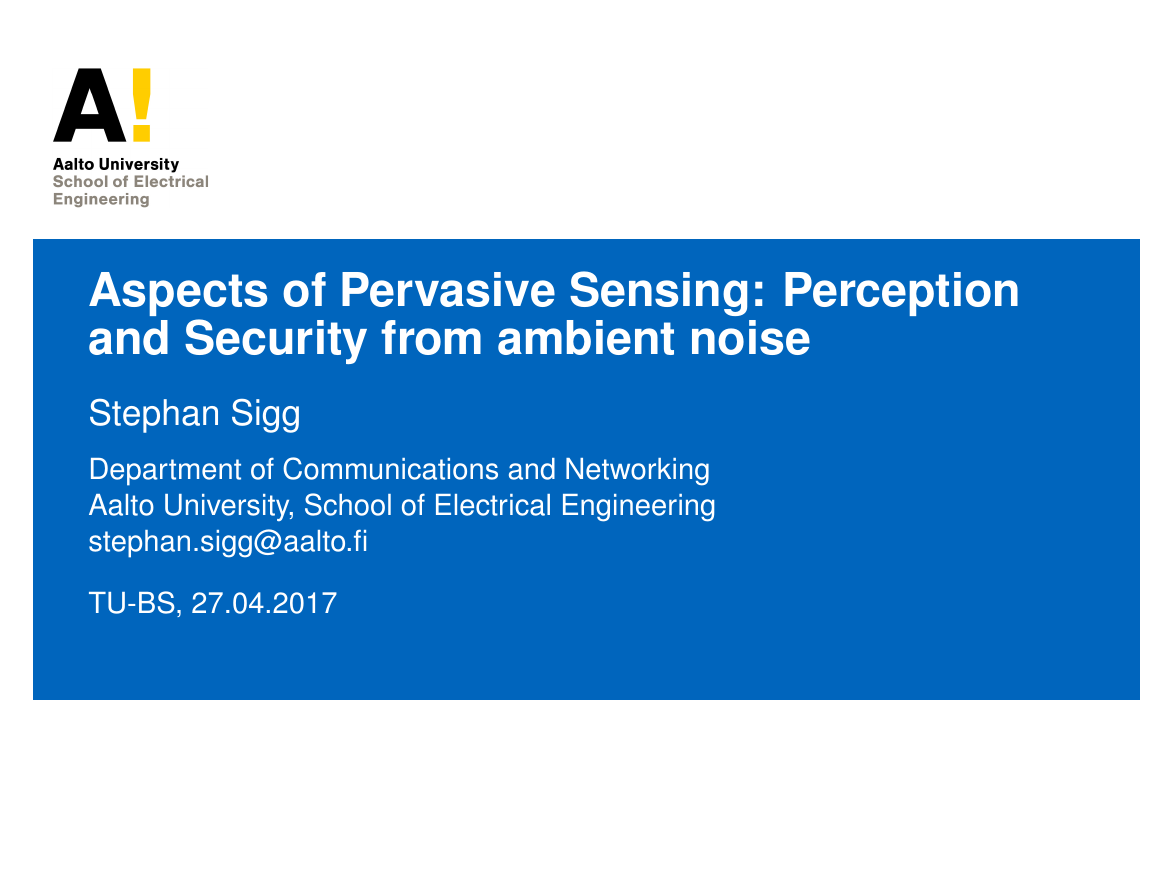


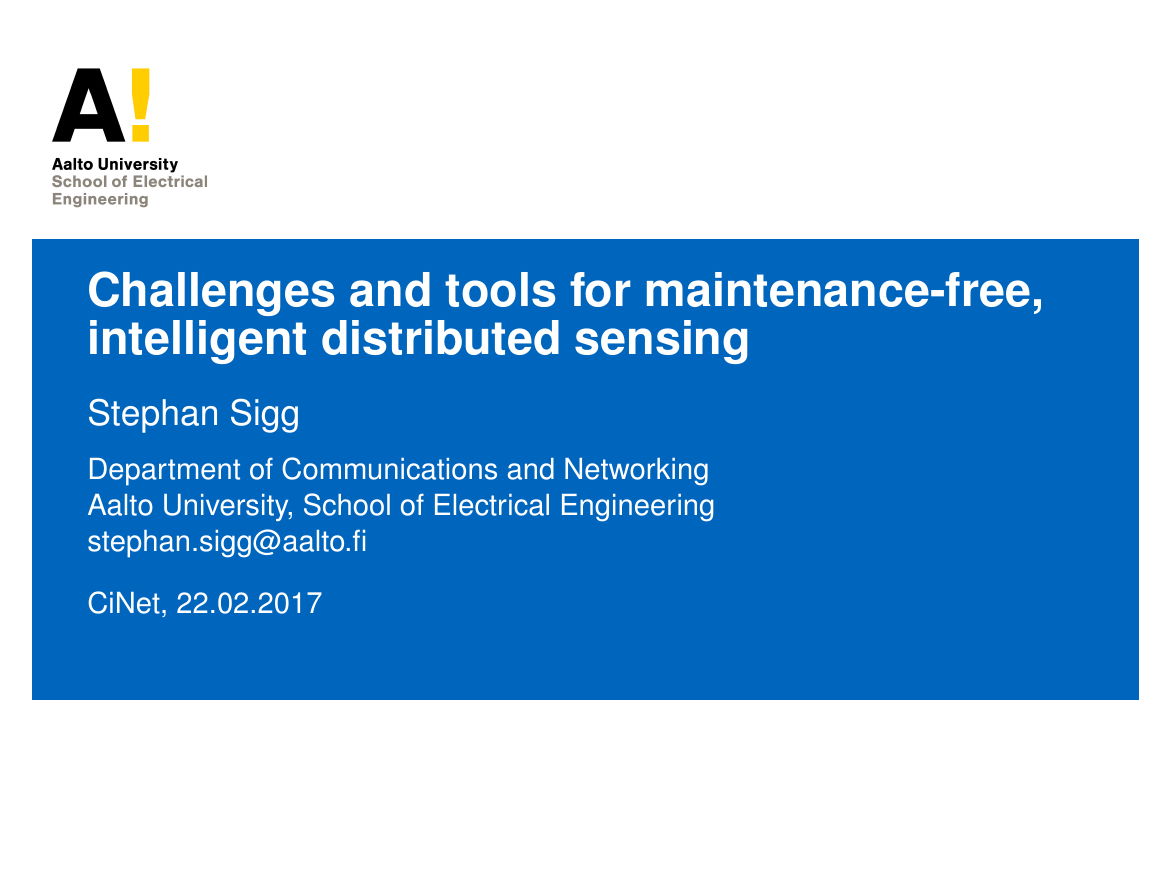
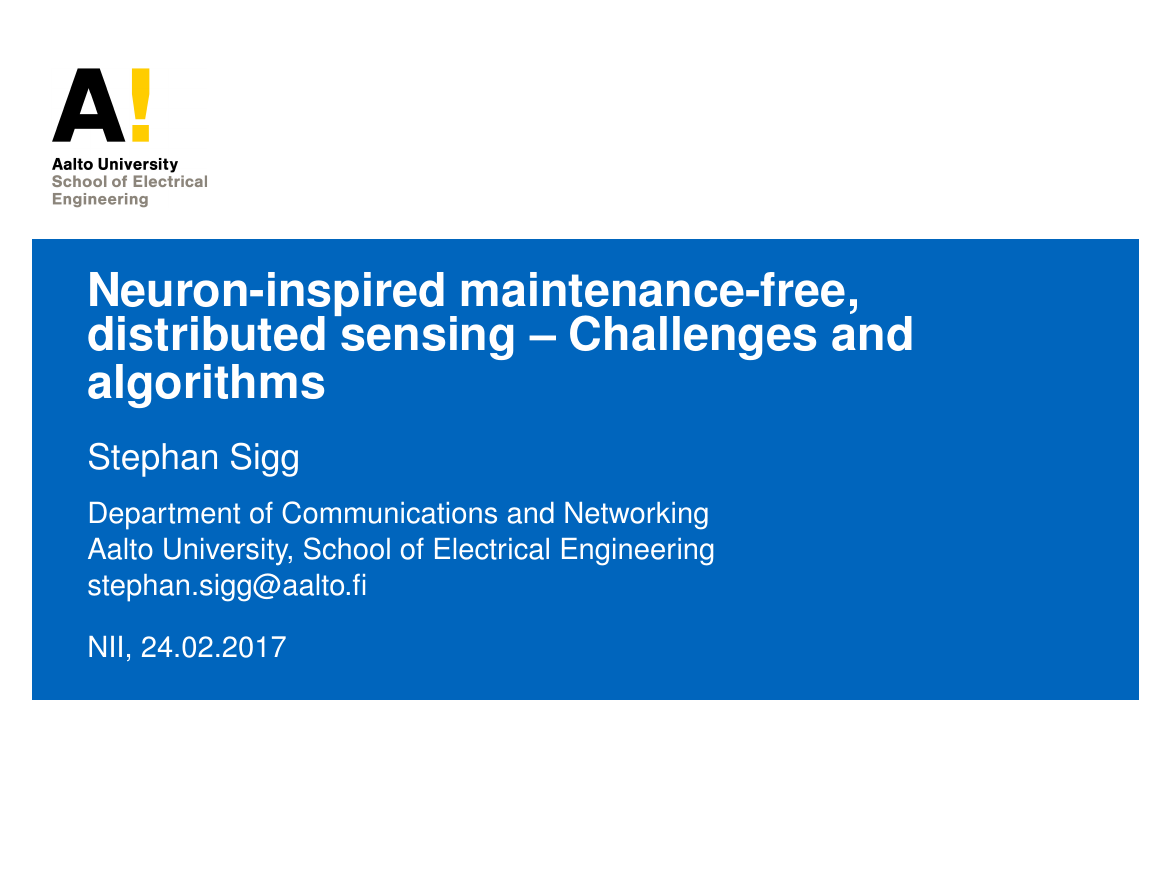

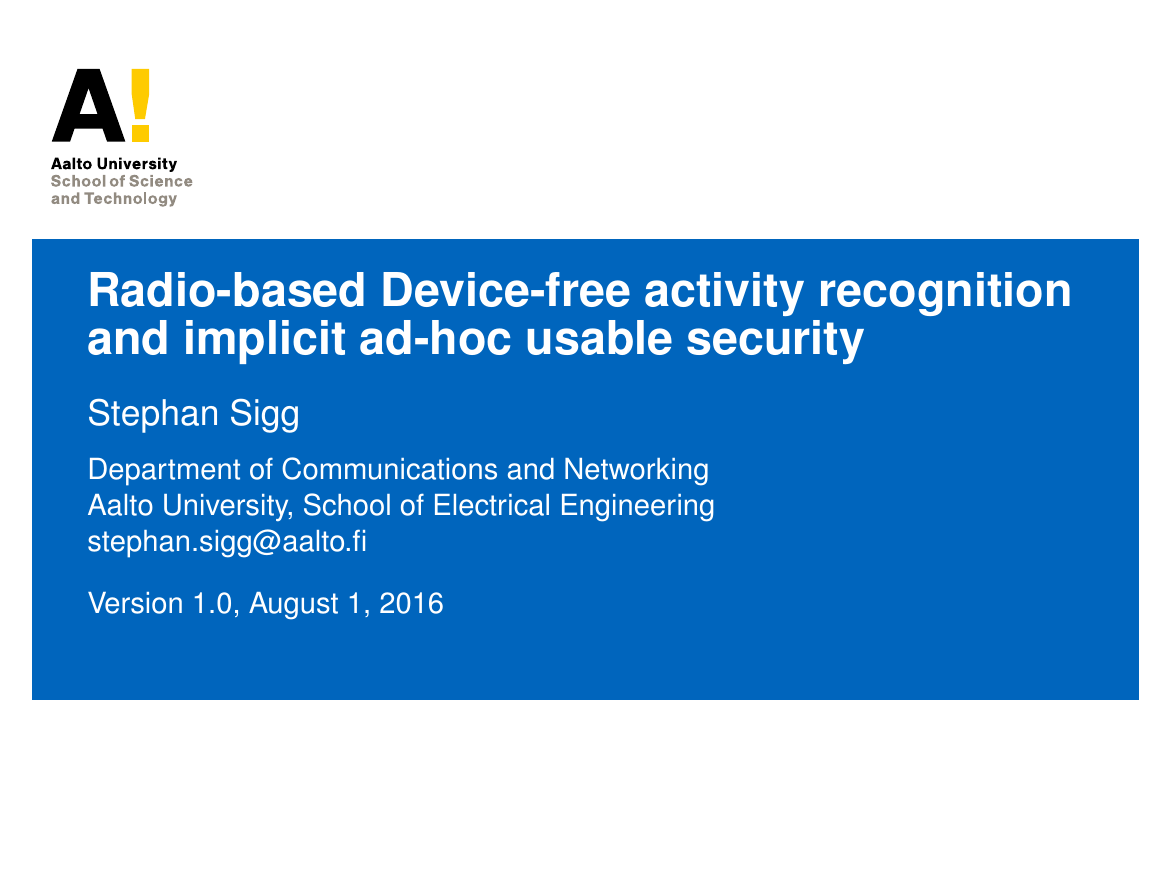
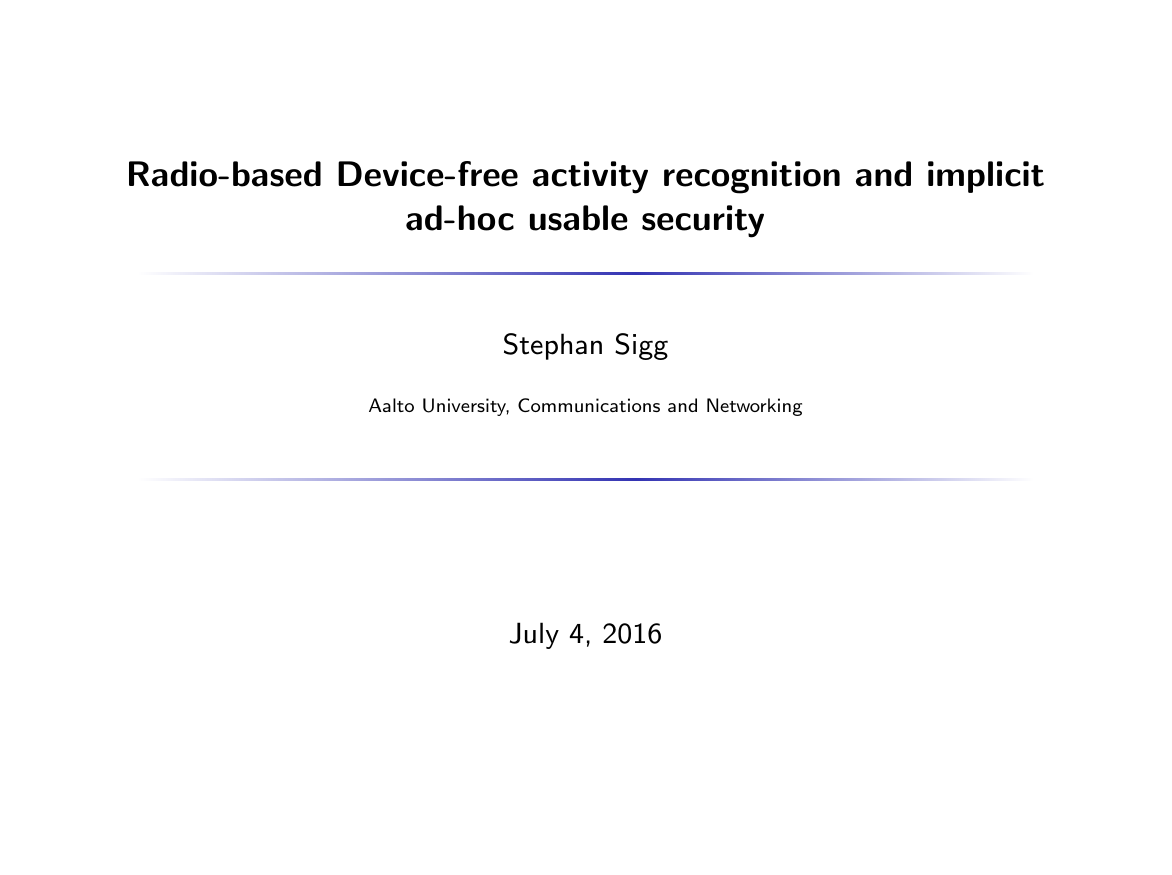
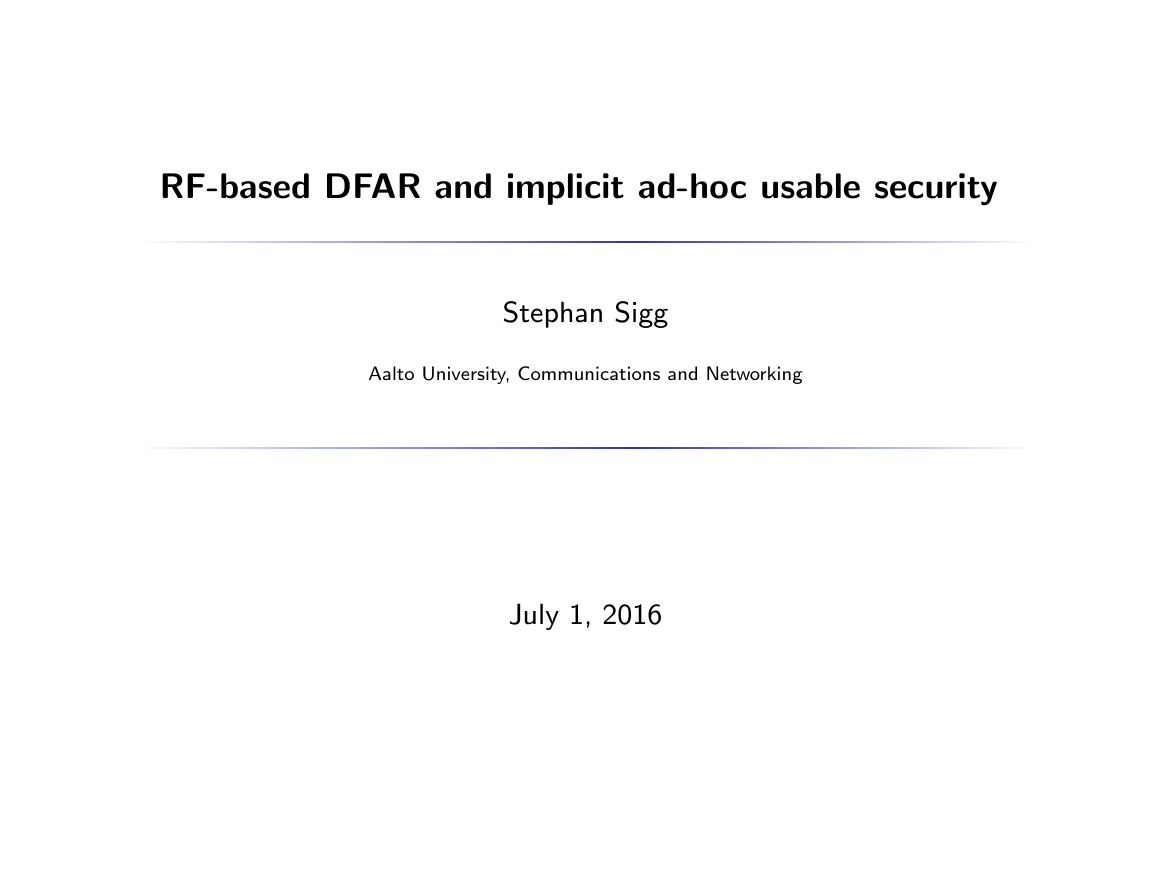

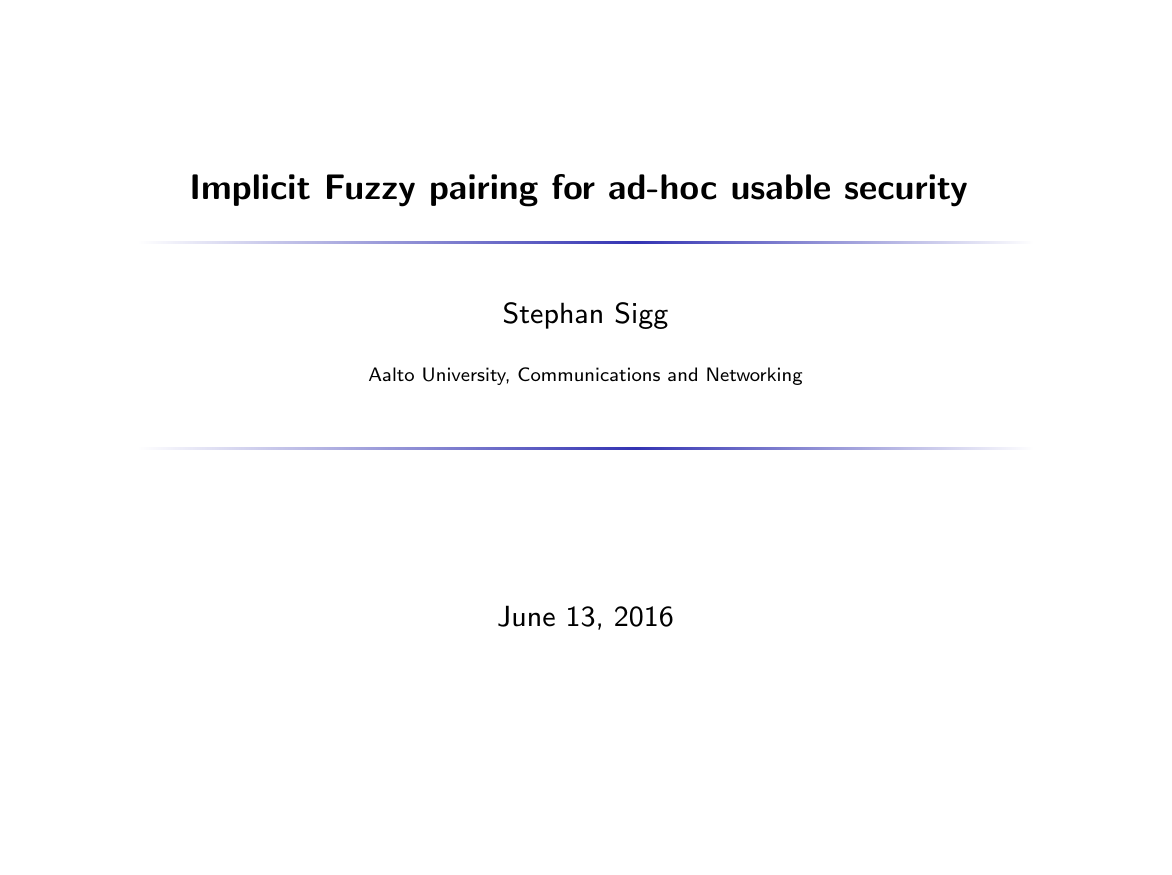
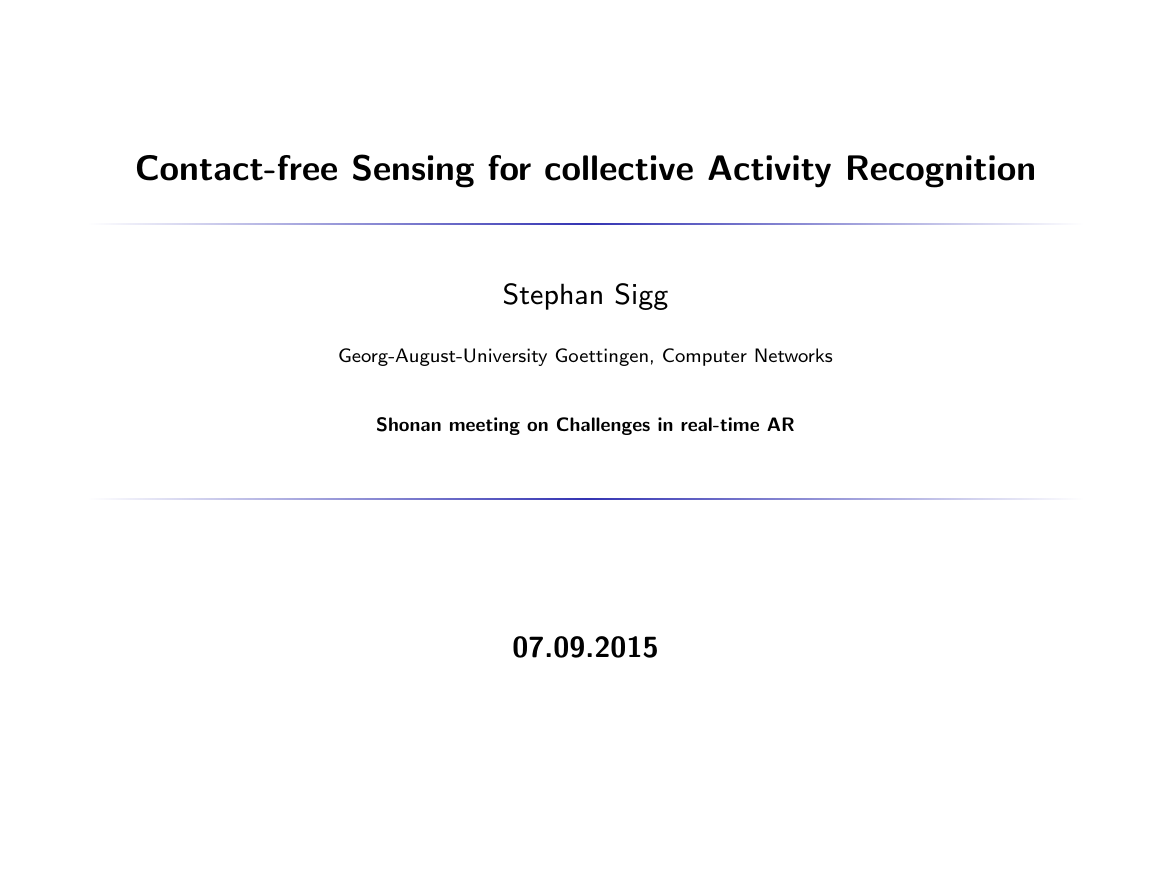
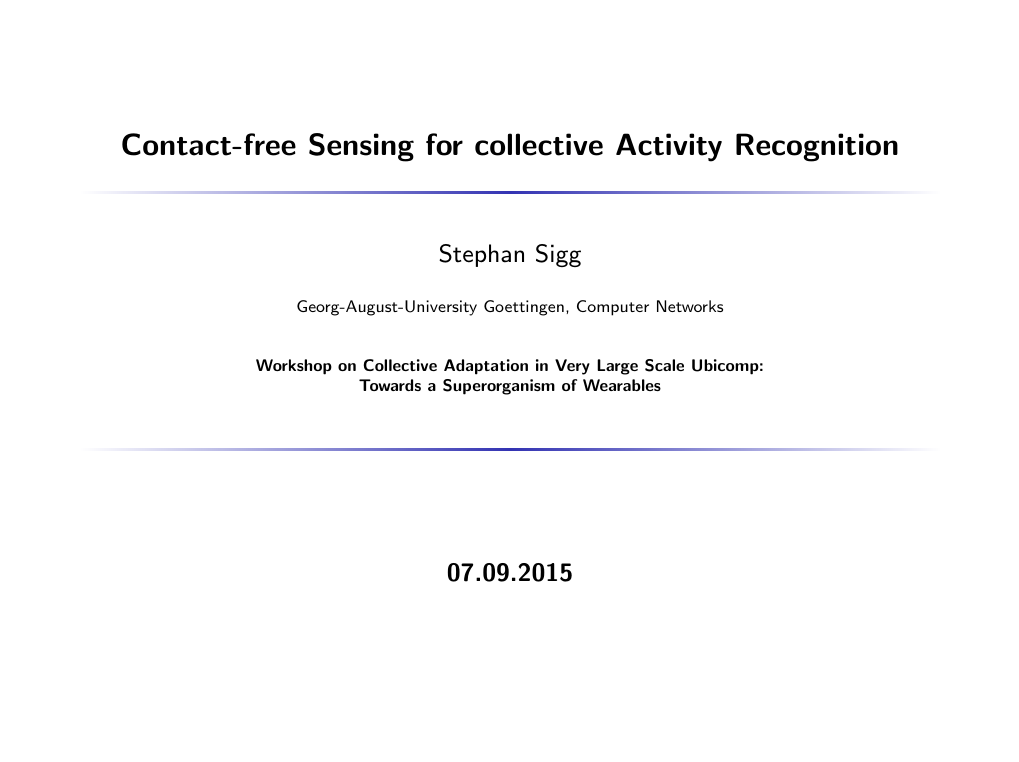

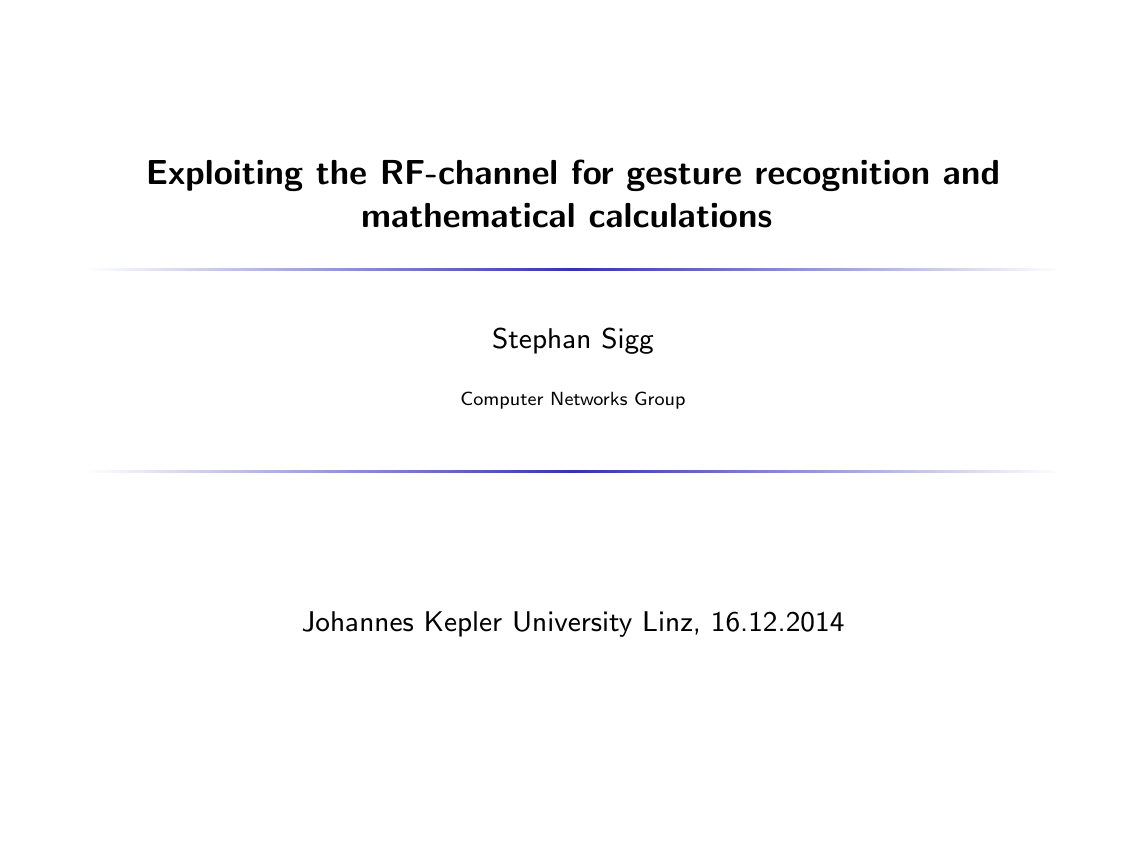

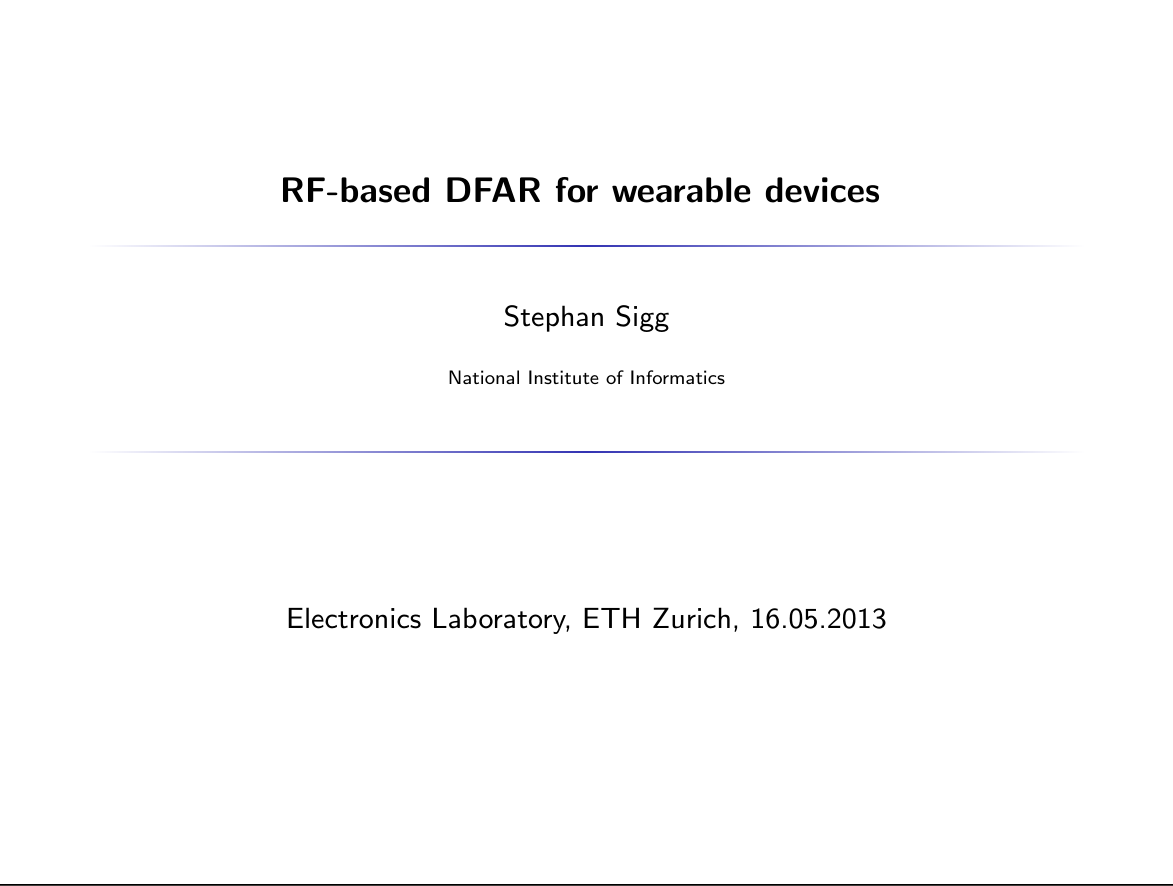
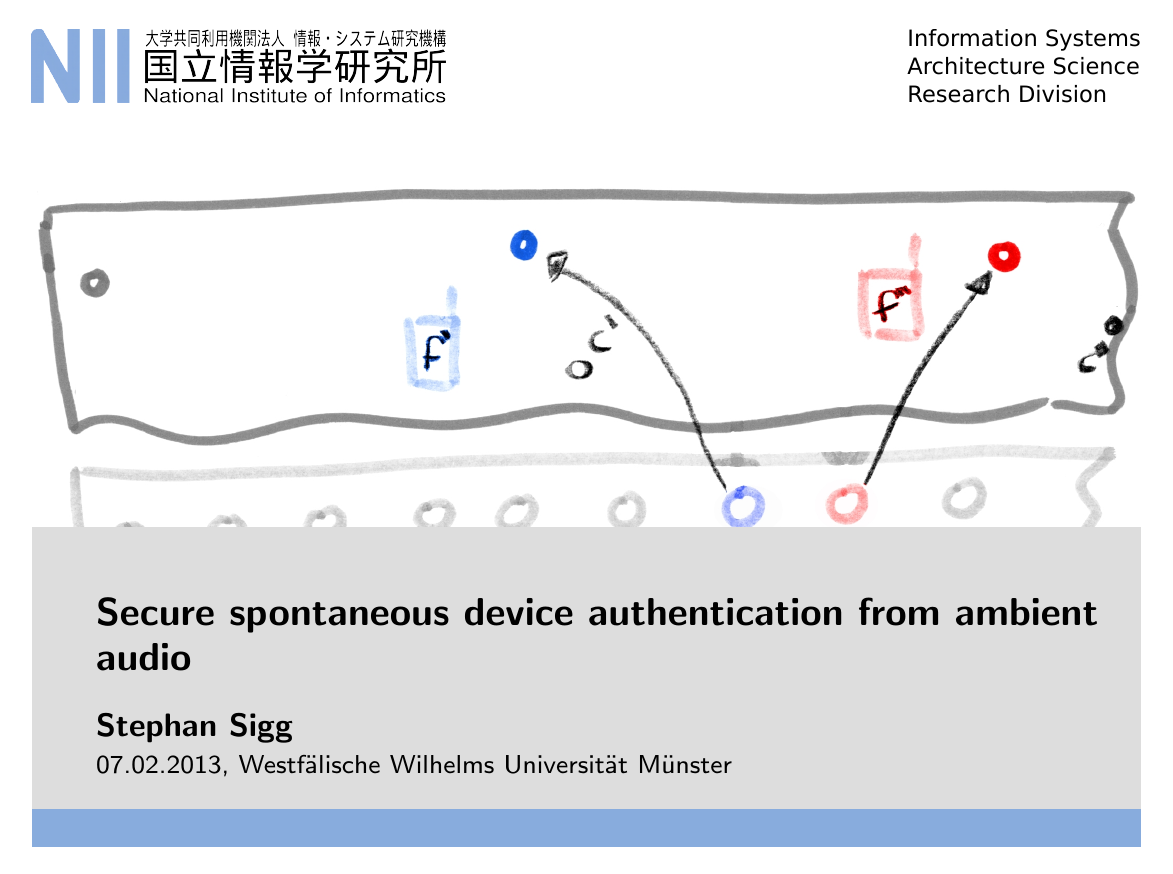
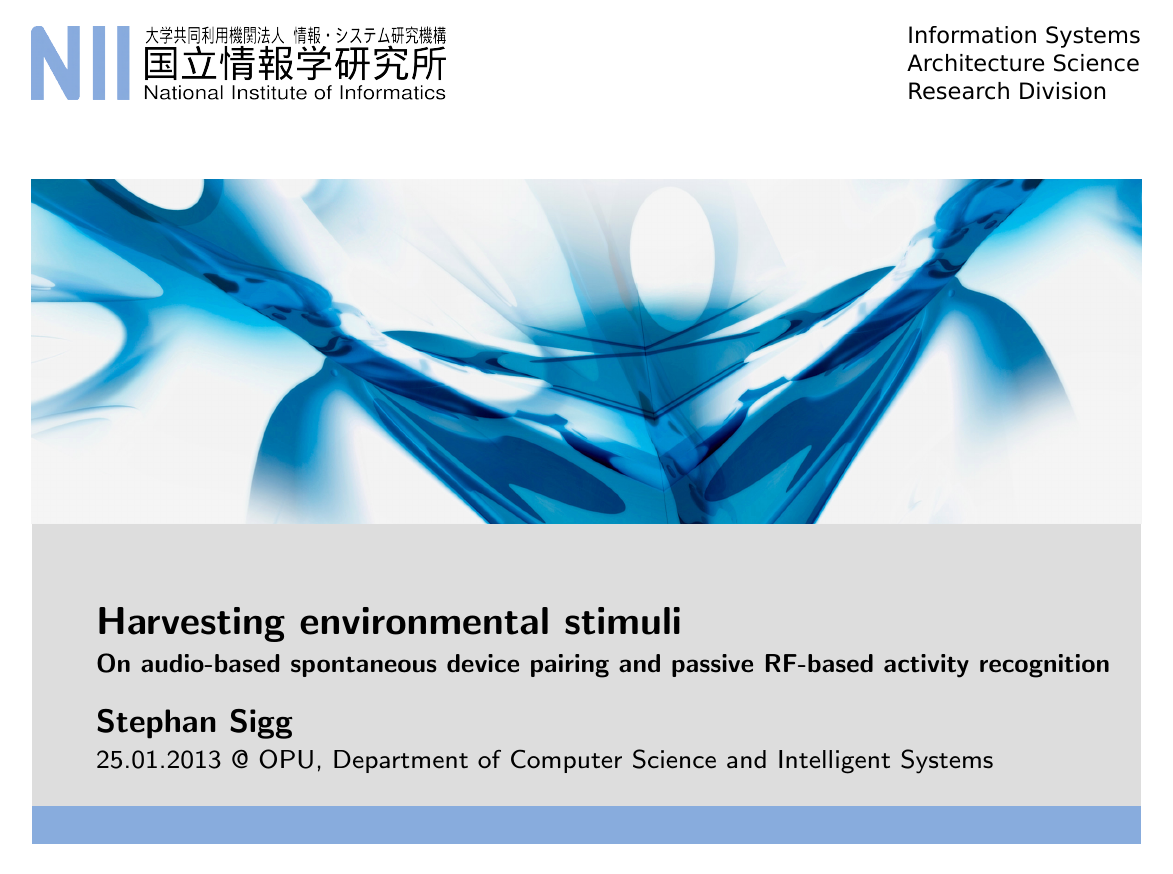

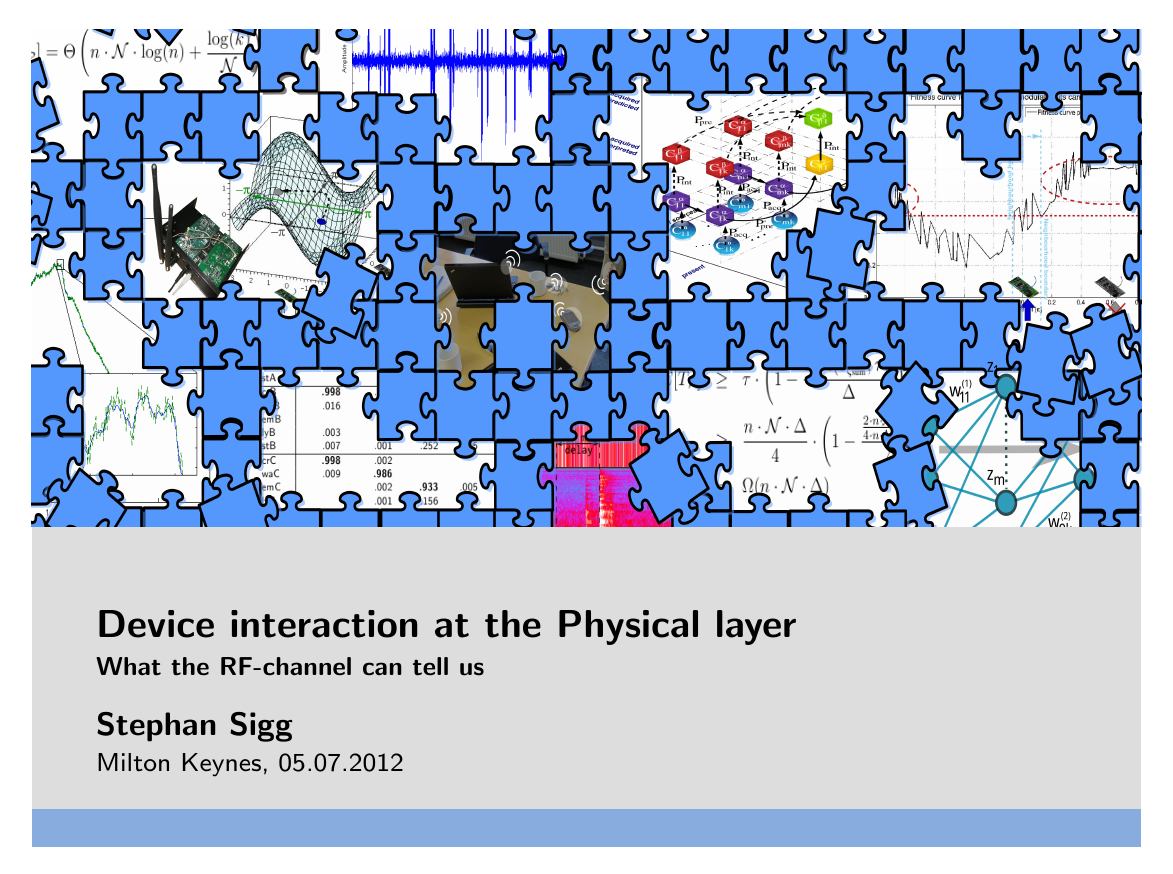
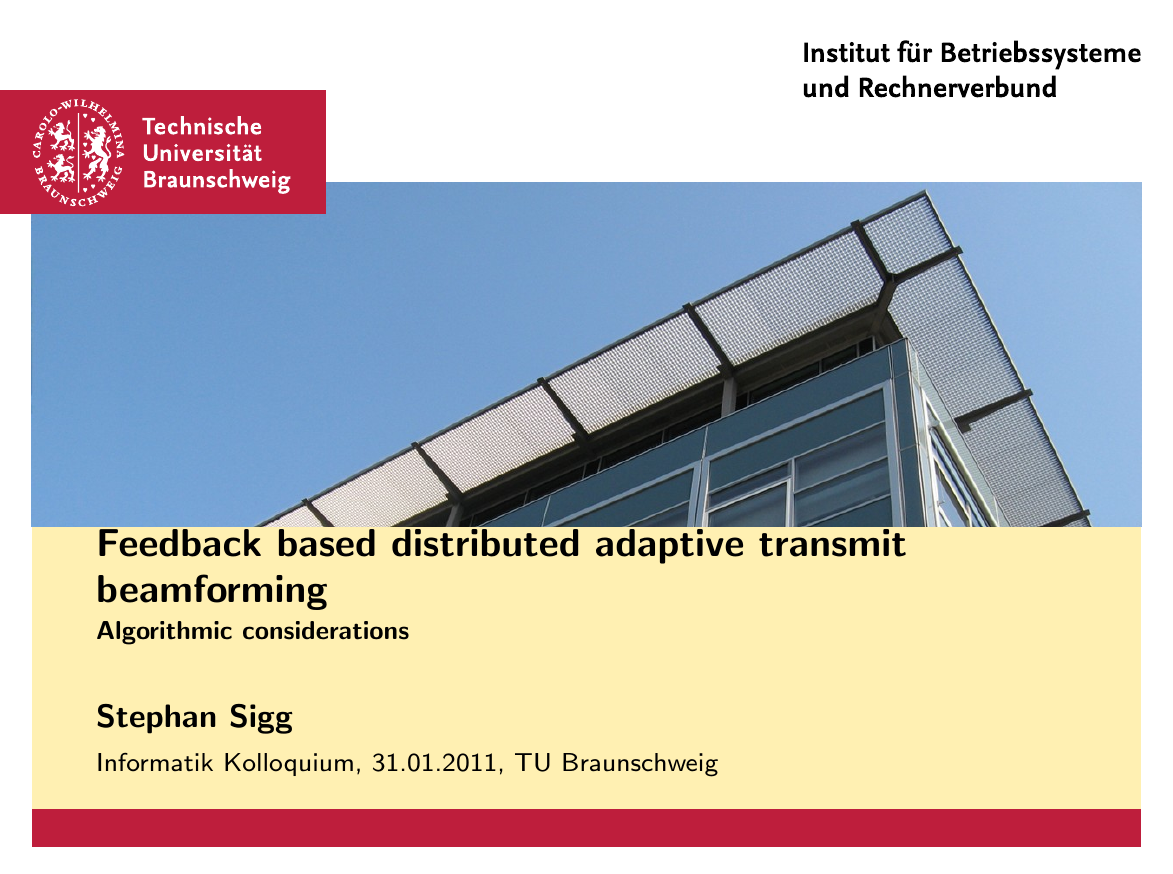
 Beamsteering for Training-free Counting of
Multiple Humans Performing Distinct Activities
Beamsteering for Training-free Counting of
Multiple Humans Performing Distinct Activities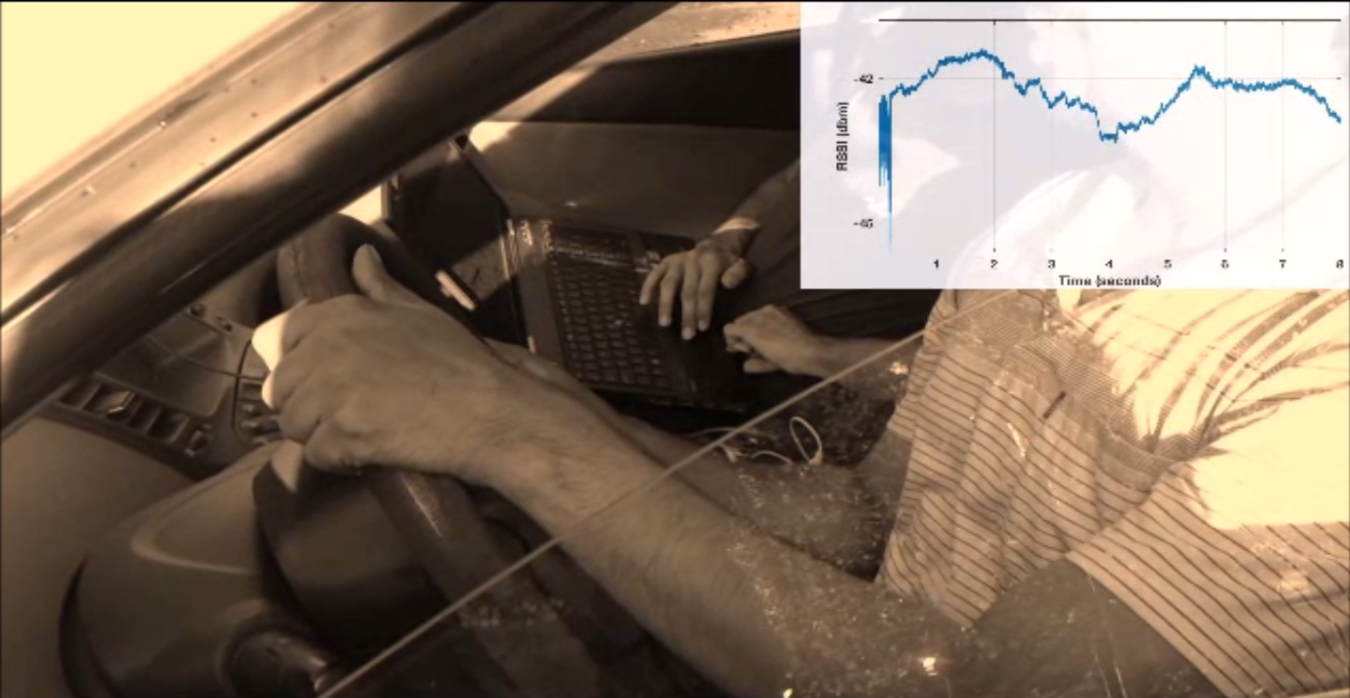 RFexpress! - RF Emotion Recognition in the Wild
RFexpress! - RF Emotion Recognition in the Wild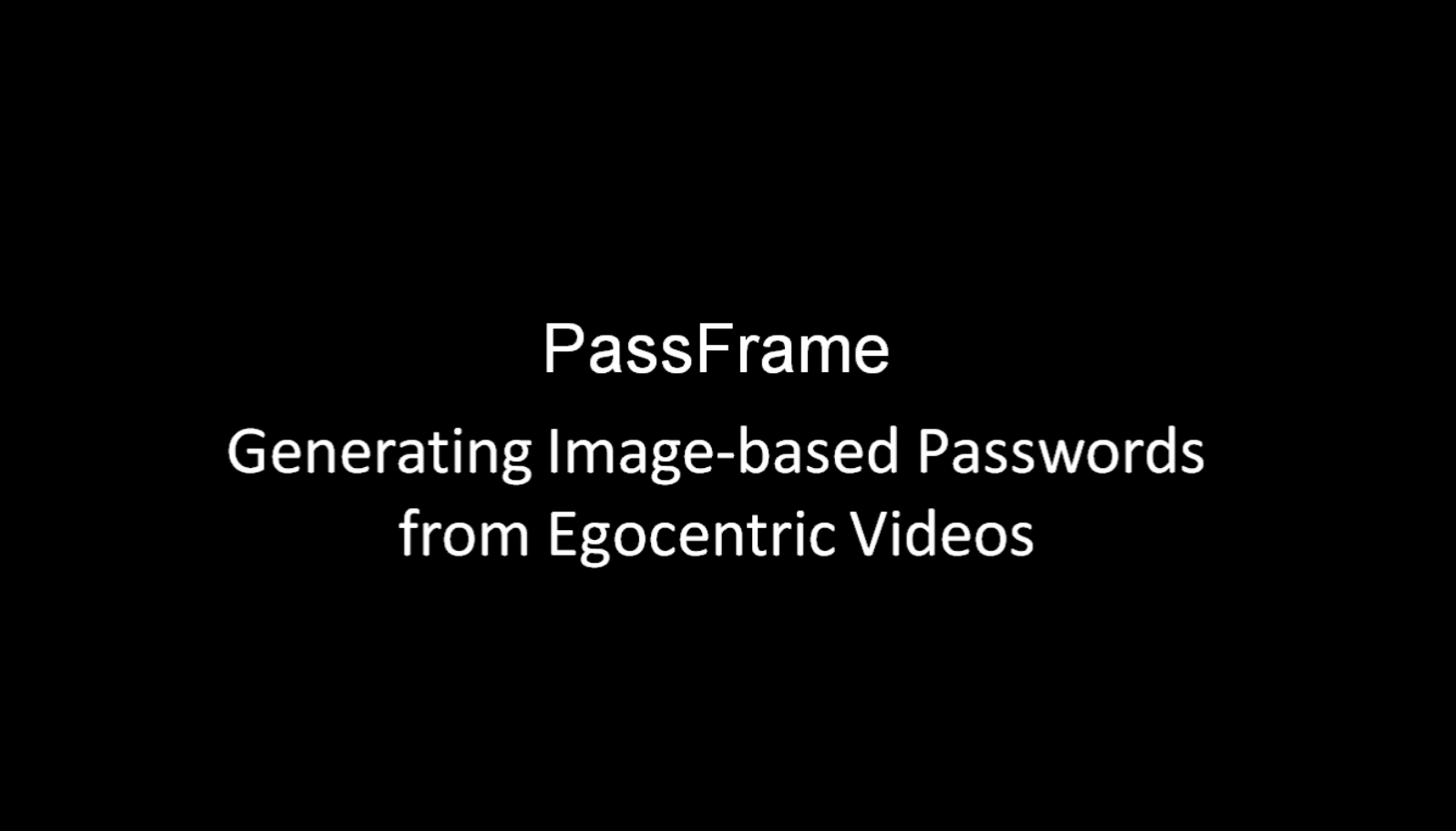 PassFrame: Generating Image-based Passwords from Egocentric Videos
PassFrame: Generating Image-based Passwords from Egocentric Videos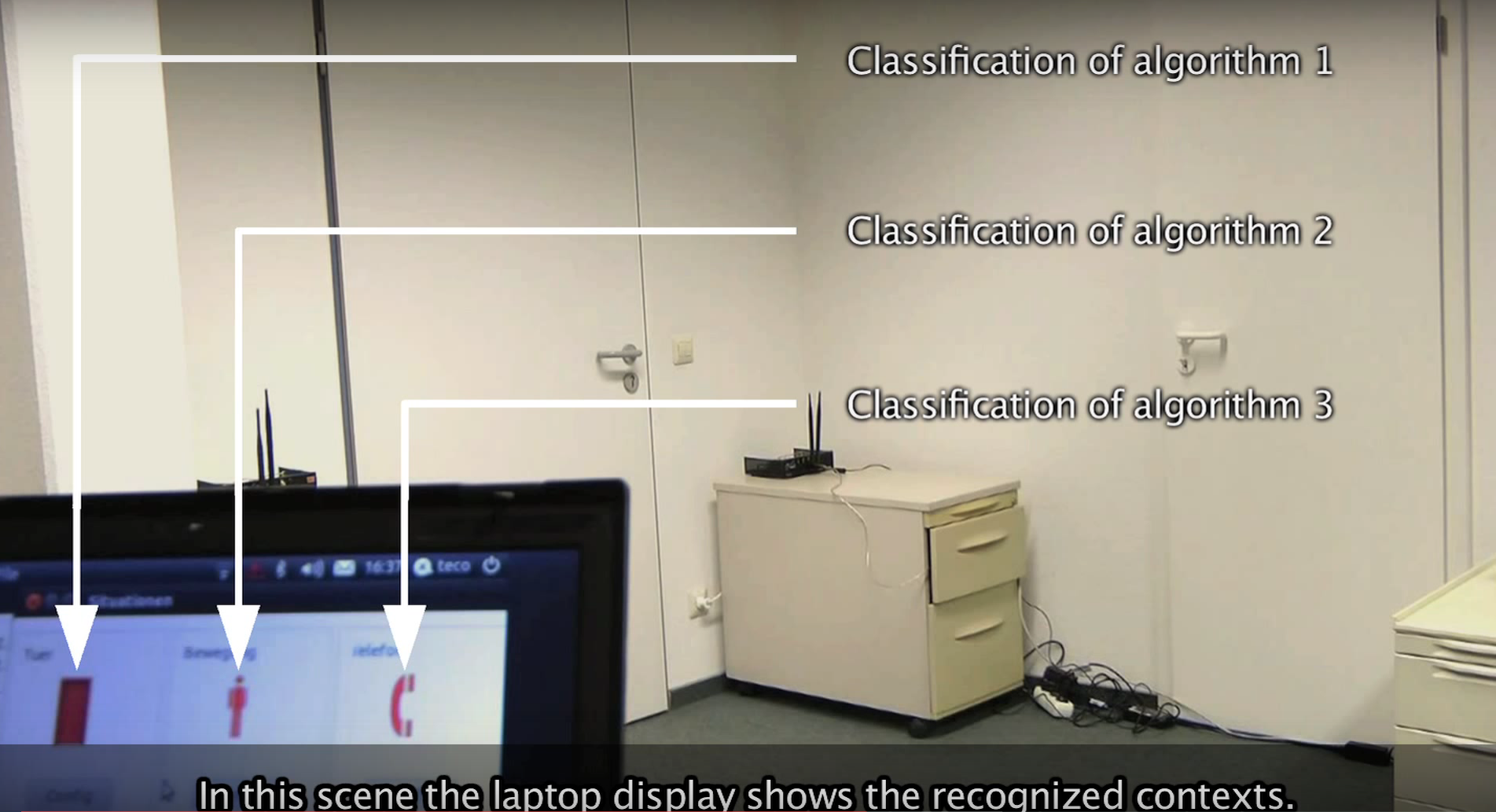 SenseWaves: Radiowaves for context recognition, Pervasive 2011
SenseWaves: Radiowaves for context recognition, Pervasive 2011
